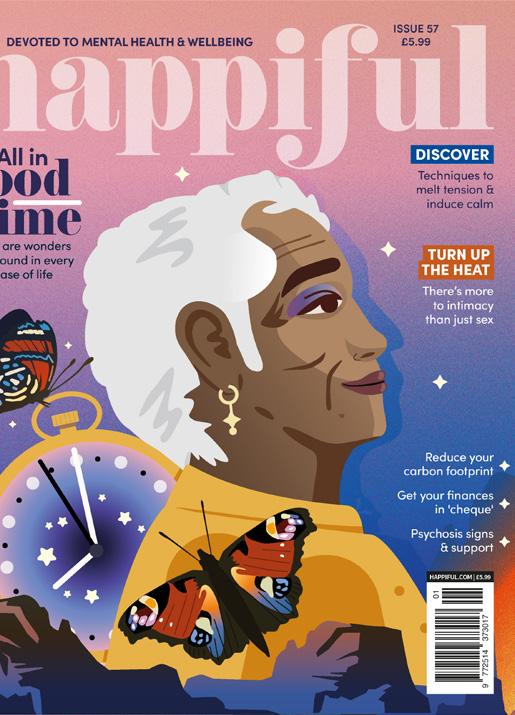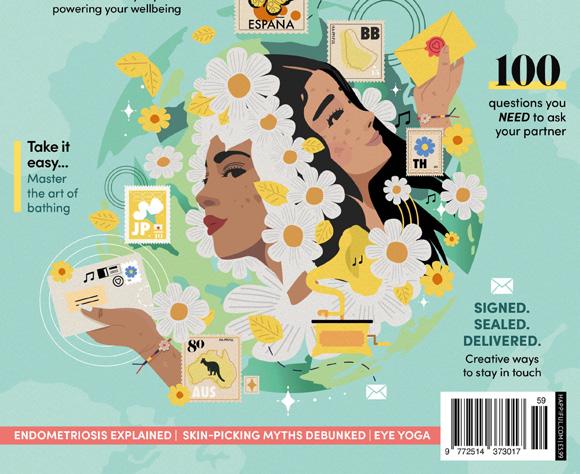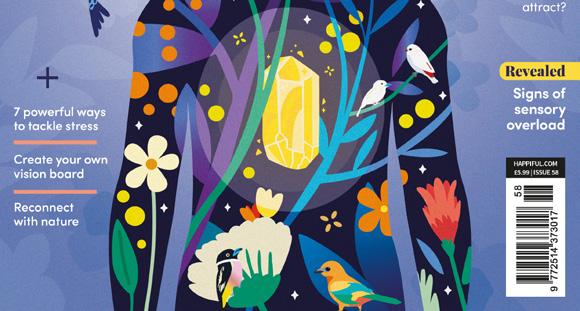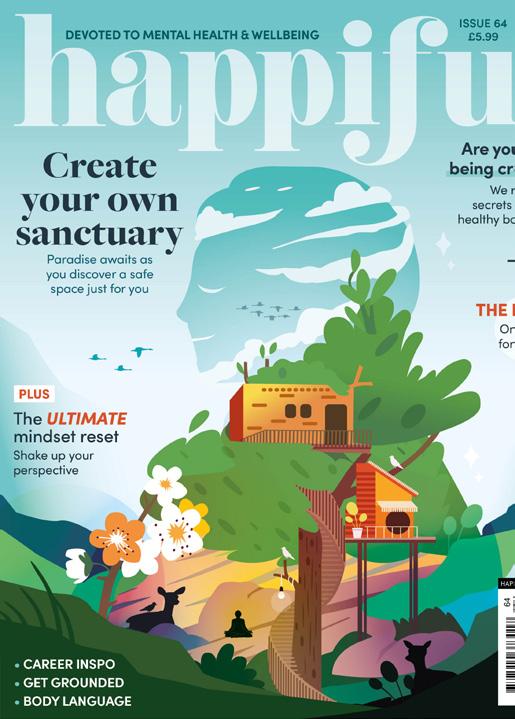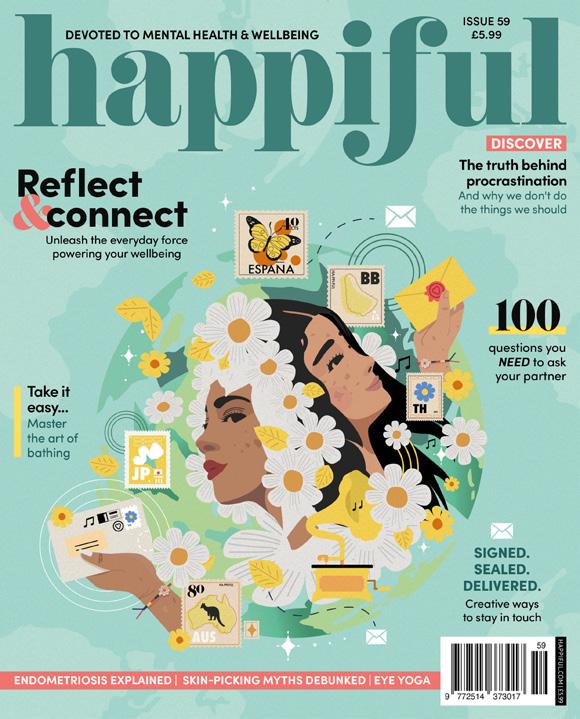Discover a splash of global inspiration to turn your life technicolour

Or unrequited infatuation...
“The whole point is to live life and be – to use all the colours in the crayon box
RUPAUL
 Photograph | Barcelos_fotos
Photograph | Barcelos_fotos

Discover a splash of global inspiration to turn your life technicolour

Or unrequited infatuation...
“The whole point is to live life and be – to use all the colours in the crayon box
RUPAUL
 Photograph | Barcelos_fotos
Photograph | Barcelos_fotos
Have you ever been told to ‘be like a swan’? It’s a common analogy where the intention is to appear like a graceful swan, gliding along the surface of the water, while underneath (and out of sight) you’re paddling frantically.
It’s supposed to represent the elegance and excellence of a person making everything seem effortless, while working hard behind the scenes. And while it’s often used to encourage ‘leadership qualities’, it’s a metaphor that came to mind while collating this issue with regard to the expectations and pressures, both external and internal, on our mental health.
Whether it’s a self-enforced fear of judgement, or persistant stigma in society, while strides might have been made in normalising mental health conversations, there remains an expectation to wear a mask, day-to-day, and not reveal your true mental state to the world. To only ask for help in a crisis, and somehow find a way to muddle along in the meantime.
This can arise when faced with the dreaded ‘So, what do you do?’ question, while taking time off work for your mental health (p21), or in forcing yourself to maintain a level of normalcy with high-functioning depression hiding in plain sight (p15). But what these articles reinforce is that you don’t have to feel ashamed of your experience or disguise your feelings in the shadows.
Throughout this edition, we’re emphasising the stigma-smashing ways to break free from this metaphorical
‘swan’ ideal, and instead accept that it’s OK to not be unflappable.
With this in mind, our expert columnist shares how to open up your throat chakra to enable you to align your head and heart as you express yourself fully (p56). And our feature on chosen family encourages you to ‘find your tribe’ as a mental wellbeing support network (p66).

Brené Brown said: “Vulnerability sounds like truth and feels like courage. Truth and courage aren’t always comfortable, but they’re never weakness.”
If you take one thing away from this issue, know this: you don’t have to put on a brave face. In fact, the bravest thing you can do is to be honest, and authentically you.
You don’t have to be fine all the time, and working on yourself is commendable. And when you share that, you pave the way for others to step out of the shadows, too.
Happy reading,
REBECCA THAIR | EDITOR-IN-CHIEF
At Happiful, inclusivity, representation, and creating a happier, healthier society are at the forefront of our mission. To find out more about our social and environmental pledges, visit happiful.com/pledges
W | happiful.com
F | happifulhq
X | @happifulhq
I | @happiful_magazine







Every
of Happiful is reviewed by an accredited counsellor, to ensure
deliver the highest quality content while handling topics sensitively.
The demands of life can pull us in many different directions – some willingly, and some not so willingly. However, when required, it’s important to define our own direction, and look after our own wellbeing – as opposed to meeting the demands of others. Check out p78 to explore how you can create time for yourself in a caring and focused manner. The greater the connection with the self, the greater connection we will have with the world and others. It’s imperative that we all create space to allow this to happen.

Meet the team of experts providing information, guidance, and insight throughout this issue

CLAIRE ELMES
BA ILM L7 EC MNLP CBT EMDR LPC
Claire is a breathwork and ice bath facilitator, and therapeutic coach.

NIKITA THAKRAR
NLP
Nikita is a multifaceted teacher, mentor, and coach, supporting people to find their life purpose.

GEORGINA STURMER
BA (Hons) MBACP
Georgina is an integrative counsellor helping clients create a more confident life.

DR JOE BARKER
BSc MSc CPsychol DClinPsy PgCert
Dr Barker is a chartered clinical psychologist supporting people with trauma.

RHS Dip Foundation Dip RBGE Dip
Ingrid is a life coach helping you to feel confident and empowered.


BSc DipION mBANT
VJ is a registered nutritionist and an expert in autoimmune disease.

ICEEFT Cert: EFCT EFFT EFIT MBACP
Andrea is a relationship therapist passionate about restoring harmony.

DipNT mBANT CNHC
Minal is a nutritional therapist and trauma-informed wellbeing coach.

BA(Hons) Dip.Couns MBACP
Lianne is a person-centred counsellor with experience across a range of issues.

SARAH WHEELER
YTT 200HR
Sarah is a reiki master teacher, yoga teacher, and self-help author.

MA PGDip LTCl ATCl QTS MHCPC
Fiona is a dramatherapist and teacher working with all ages.
EDITORIAL
Rebecca Thair | Editor-in-Chief
Kathryn Wheeler | Features Editor
Lauren Bromley-Bird | Editorial Assistant
Bonnie Evie Gifford, Kat Nicholls | Senior Writers
Becky Banham | Content & Marketing Officer
Michelle Elman, Nikita Thakrar | Columnists
Ellen Lees | Head of Content
Keith Howitt | Sub-Editor
Rav Sekhon | Expert Advisor
ART & DESIGN
Amy-Jean Burns | Head of Product & Marketing
Charlotte Noel | Creative Lead
Rosan Magar | Illustrator & Videographer
COMMUNICATIONS
Alice Greedus | PR Manager
Emily Whitton | Marketing Coordinator
CONTRIBUTORS
Fiona Fletcher Reid, Kai Conibear, Lydia Wilkins, Caroline Butterwick, Laura Cooke, Jenna Farmer, Lara Green, Kate Orson, Rebekah Crilly, Minal Sudra, Jamie Windust, Ellen Manning, Kerry Law
SPECIAL THANKS
Andrea Tibbitts, VJ Hamilton, Dr Joe Barker, Sarah Wheeler, Ingrid Van Oostrom, Georgina Sturmer, Fiona Van Zyl, Lianne Terry, Claire Elmes
MANAGEMENT
Aimi Maunders | Director & Co-Founder
Emma Hursey | Director & Co-Founder
Paul Maunders | Director & Co-Founder
SUBSCRIPTIONS
For new orders and back orders, visit shop.happiful.com, or call Newsstand on +44 (0)1227 277 248 or email subenquiries@newsstand.co.uk
CONTACT
Happiful, c/o Memiah, Building B, Riverside Way, Camberley, Surrey, GU15 3YL Email us at hello@happiful.com
HAPPIFUL FAMILY
Helping you find the help you need. Counselling Directory, Life Coach Directory, Hypnotherapy Directory, Nutritionist Resource, Therapy Directory
Are you a wellbeing expert with valuable insight to share? Happiful professional membership includes opportunities to be featured in our award-winning magazine. Discover how to join by emailing us at professionals@happiful.com

‘Get
Music is an incredibly powerful force, particularly for those with dementia. It can spark memories, and happy thoughts and feelings, even when so much else has been lost. So, for those who also enjoyed reading throughout their lives, bringing music and stories together seemed like the natural thing to do for one specialist book publisher.
Looking back at… The Beatles is a new book from publisher Cognitive Books, developed in collaboration with the Alzheimer’s Society, which focuses on the story of the worldfamous band The Beatles.
Using familiar stories, rhyme and rhythm for recall, and illustrations to bring the story to life, each page is designed to be like a story in itself, in order to make the reading experience a relaxing and enjoyable one. With accessibility in mind, there is also an audiobook version narrated by actor Bill Nighy.

Matt Singleton is the founder of Cognitive Books, and author of Looking back at… The Beatles, and shares how his decision to found Cognitive Books came about after seeing his own father, who loved reading, became unable to read as his condition progressed.
“I desperately searched for books that would be more suitable for him to enjoy,”
Matt says. “But I came up with nothing. Given my knowledge of dementia, and innovation due to both my masters’ degree in gerontology, and work, I seized the opportunity to solve the problem and that’s how the idea of Cognitive Books was born.”
‘Looking back at… The Beatles’ is out now, and available to order from shop.alzheimers.org.uk
Writing | Kathryn Wheeler


internet use actually be good for our wellbeing?
It can be easy to point to the internet as the source of a lot of our problems these days. Comparison traps, information overload, negativity biases, and countless other negative features, are closely associated with our internet culture. But is there another side to this story?
In a new study by the Oxford Internet Institute (OII), that used data from 168 countries, findings showed that those who had internet access, or actively used the internet, reported greater levels of life satisfaction and social wellbeing.
The researchers gathered data between 2006 and 2021 from more than two million individuals worldwide, aged between 15 and 99. They looked at eight indicators of wellbeing, including life satisfaction, daily negative and positive experiences, and community wellbeing. In 85% of cases, there were associations between internet connectivity and wellbeing that were positive. However, in the 5% of cases where it was negative, this experience was most observed among young women aged 15 to 24 – a finding that is consistent with other research, which has found links between increased internet usage and depressive symptoms among young women and teenage girls.
The research comes at a time when governing bodies across the world are looking into new laws in response to concerns about online safety. Following the findings in this study, the researchers called for lawmakers to consider the data before rushing into any decisions. And while there are still many ways in which internet usage can negatively affect us, with the right guidance and considered safety measures in place, it appears it can be a positive force for many.
Writing | Kathryn WheelerAccording to research published in The Lancet Psychiatry, conducted by charity Bipolar UK, there is a link between bipolar and hypersexual behaviour – and the discovery could be key to supporting hundreds of thousands of people in the UK.
In a survey of 1,500+ people with bipolar, 88% of respondents
had experienced the symptom of hypersexual behaviour, which suggests this could also impact the majority of the 1 million UK people who live with the condition.
Defined as an ‘unusual or excessive concern with or participation in sexual activity’, researchers explain that people with bipolar may experience
hypersexual behaviours as part of hypomania or a manic episode –times when they are more likely to take risks.
But the research is being warmly welcomed by the charity, which believes it will come as reassurance to many who felt guilt or shame around this symptom.
Writing | Kathryn Wheeler
Undergoing surgery can be really scary, especially for children. But, a team of highly intelligent researchers have developed something that will make the experience less intimidating, and the driving force behind it? A robot car.
According to a study conducted by Sant Joan de Déu Barcelona Children’s Hospital, six out of 10 young patients who undergo surgery experience stress before receiving anaesthesia. While pharmacological strategies are used to ease this, the side-effects can cause the experience to be more stressful.
Working with the hospital to explore alternative solutions, researchers from the Universitat Oberta de Catalunya developed a robot car as an initiative to
reduce feelings of fear and anxiety. This innovative product can detect the emotions of the children by their facial expressions, heart rate, and breathing patterns, while adapting to their needs by interacting with them, changing colour, making music, and creating smells.
It was tested in a pilot study of 86 children aged between three and nine from 2020 to 2023, and received positive feedback from both the children and their parents.
Speaking fondly of this, paediatric nurse Carmen Jerez, said: “It gave the children the feeling of control, and having an active role in the process without realising it, in a way that was fun.”

Though it has been put on hold while it awaits funding to develop a new prototype, it’s clear that this technology is capable of revolutionising the wellbeing support of children in healthcare settings.
Writing | Lauren Bromley-Bird
19-year-old Lloyd Martin became the youngest person with Down’s syndrome to complete a marathon after finishing the London race
The city of love seems to have found a new adoration for cycling, as a study reports that more people now travel by bike than car in the centre of Paris! The urban planning agency, Institut Paris Region, revealed that, while walking (53.3%) and public transport (30%) remain the most popular methods of travel in the capital, Parisians use bikes for 11.2% of their trips v cars for just 4.3%. Seems like a city on the right track with its travel priorities.
US honeybee population hits an all time high with 3.8 million colonies – growing by a million in the past five years
Creating sexually-explicit ‘deepfake’ images set to be a criminal offence under a new law announced by the Ministry of Justice
The Crown Prosecution Service has updated its guidance to recognise ‘love bombing’ as a sign of abuse
Feel guilty for taking a ‘lazy day’? Well stop right there, because there’s scientific evidence it’s good for you! A paper by Yale University suggests scheduling in some time to take it easy is essential, ideally at least once a week, as it can help to reduce stress, high blood pressure, and increase creativity. So, put those feet up, and that to-do list down.
The world’s largest ‘CO2 vacuum’, based in Iceland, has been turned on!
It’s believed it can suck 36,000 tons of carbon out of the air each year.
A groundbreaking gene therapy treatment has helped restore hearing in a girl who was born deaf. Opal Sandy, 18-months old from Oxfordshire, was born with auditory neuropathy and is the first patient to receive this treatment, offering promising possibilities for the estimated 20,000 people in the UK, Germany, France, Spain, and Italy with similar conditions.
We Are Survivors, a Manchesterbased charity looking to create safe spaces for male (including trans and non-binary) survivors of sexual abuse, exploitation, and rape, has revealed it’s had an 80% increase in first-time callers. The charity also says that in the first two weeks of the launch of the Netflix show Baby Reindeer, 53% of all referrals claimed the show was the main reason they reached out for support. It goes to show that tackling hard-hitting topics in mainstream media can have a positive impact, and connect people with the support they need.
The annual Comedy Pet Photo Award celebrates the joy and laughter our animal friends bring into our homes and lives, with this year’s finalists including windy pups, guffawing donkeys, and mischievous cats. Visit comedypetphoto.com to view the gallery and find out the winner on 6 June.
Scientists have made a breakthrough in the fight against brain cancer. Researchers from the University of Florida trialled a personalised brain cancer vaccine, which triggers the immune system to attack the disease – noting that a response was seen within just two days! This initial human trial featured just four people, and so further research is lined up and necessary, but it poses hope for a cure for cancer in the future.
NDN Book Club, a non-profit literary organisation run by and for Indigenous people, hit the road in April to distribute 10,000+ books in New Mexico. The charity’s pink truck was on a mission to both support Indigenous writers, and help improve literacy in the Navajo Nation, with the free books, along with donations gathered by sponsor 4KINSHIP distributed across the reservation, and a huge increase on the 2,000 given out the previous year!
ARE... It’s how old you feel. A study in the journal Psychology and Aging found that ‘old age’ is being perceived as starting later in life by middle-aged and older adults, compared to those in decades past. It’s a sure sign that age is just a number.
From the chirp of a blackbird in the classic song by The Beatles, to rain in Ariana Grande’s ‘POV’, nature can play a special part in music – and now, it’s finally being recognised. Artists can list ‘Nature’ as a featured artist, which means a share of the royalties will go to environmental causes. That’s music to our ears.
Why do some people find it hard to take action when it’s needed the most?Writing | Kathryn Wheeler
Have you ever felt frozen to the spot during a tense moment, or in an emergency? Or hesitant to step in and take action, more like an extra passing through the scene than a featured actor? If so, you may have experienced the ‘bystander effect’ – a social psychological theory that proposes that individuals are less likely to step up to offer help to another when other people are around.
The theory was first proposed back in 1964, in light of the murder of Kitty Genovese, a 28-year-old woman who was assaulted and killed outside the apartment building she lived in. Following the murder, The New York Times published an article which claimed that 38 people witnessed the attack, yet none of them called the police or stepped up to help her – though this was called into question later. But from this incident, the bystander effect (also sometimes called ‘Genovese syndrome’ after Kitty Genovese) became a regularly studied and debated phenomenon in the field of psychology.
At the time, the concept of the bystander effect was popularised by social psychologists
Bibb Latané and John Darley. Ultimately, they believed that the bystander effect was caused by two facts. Firstly, the diffusion of responsibility, meaning that because there are more people there is less personal responsibility placed on an individual, which means they feel less inclined to take action, or believe it is unnecessary as someone else will. The second is social influence, when we take our prompts from others’ behaviour – if no one else is doing anything, why should you?
But in order to develop a better understanding of what was happening, Latané and Darley carried out a series of experiments to test the bystander effect in non-emergency situations. In one, subjects asked a bystander for their name, with more people sharing their name when the participant gave their own first. In another, participants asked people for a 10 cent coin, with the number of people giving them one increasing when the participants gave a reason, such as saying their wallet had been stolen.
Latané and Darley went on to propose that there are five characteristics of emergencies that can trigger the bystander effect... >>>


Outside of emergency situations, if you are worried about an ongoing situation you can use the following resources and services:
Your local police force may have an online service where you can report non-emergency crimes, sometimes anonymously. You can also visit crimestoppers-uk. org or call them on 0800 555 111.
If you are worried about a vulnerable adult who is at risk of abuse, you can make an adult safeguarding referral via your local council website.
You can report child abuse to the NSPCC using its online form at nspcc.org.uk. The more detail you know the better, but you can still reach out even if you do not know everything about the child you are concerned about.
• Emergencies that involve a threat of harm or actual harm.
• Emergencies that are unusual and rare.
• When the type of action required in an emergency differs from situation to situation.
• Emergencies that cannot be predicted or expected.
• Emergencies that require immediate action.
physical – offering a different perspective to Latané and Darley’s early research. And in 2016, a study published in Psychology of Violence found that ‘highly masculine’ subjects were less likely to take action to help the victim than more feminine subjects.
But whatever it is that is happening in our minds when we’re faced with an emergency,
Having an awareness of the phenomena may be enough to prevent you from falling into it
And when the bystanders are in this situation, they then go through a cognitive and behavioural process: notice something is going on; interpret the situation as being an emergency; degree of responsibility felt; recognise the form of assistance; implement the action choice. All these factors play a role in whether action is then taken.
Since the work of Latané and Darley, much more research into the bystander effect has taken place – shaping our understanding of why and how it might happen. In 2011, a meta-analysis of the bystander effect published in the journal Psychological Bulletin found that the bystander effect was actually reduced when situations were perceived as dangerous, perpetrators were present, and the cost of intervening was
getting trapped in the bystander effect can come with feelings of guilt and regret. So, how can you become an active bystander instead?
To begin with, just having an awareness of the phenomena may be enough to prevent you from automatically falling into it as you rebel against inaction. But the first thing you might want to do is to look into what precisely you should do in common emergency situations. You will already know to call 999 for police, ambulance, and the fire service, but it’s also worth being aware of being able to text the British Transport Police on 61016 for crime prevention or reporting an incident that has taken place on public transport. You may also wish to brush up on your first aid skills so that you have the necessary knowledge to step in where appropriate. The
British Red Cross offers courses and online workshops, as well as information on their site at redcross.org.uk.
The same goes for growing your awareness of how to step in when you see someone showing signs of distress in a mental health context. If someone appears to be in crisis, you can call 999. Outside of an emergency, when you have noticed someone is struggling, the best thing you can do is to ask them, in a supportive way, how they are feeling.
This may apply if you have noticed that someone is withdrawn or not acting like their usual self, and also if you are worried that they may be at risk of harming themselves. Contrary to the belief that talking about suicide can put the idea in someone’s head, the advice from suicide prevention charities is to ask someone directly, but sensitively, whether they are thinking about suicide. Breaking the bystander effect when it comes to mental health can be as easy as taking the time to properly check-in with someone.
Something that is often talked about in relation to the bystander effect is fear. We won’t always know how we will react to an emergency until we’re in the moment, and at that point the fear, and any other psychological factors, may take over, rooting us to the spot. But by educating ourselves on the resources that are available, and processes that we can follow, we can take back some control and equip ourselves with the knowledge we need to take action when it is needed most.

How to recognise the more subtle signs that someone might be struggling, and exhibiting high-functioning depression
Writing | Fiona Fletcher ReidDepression doesn’t always announce itself with sadness or tears. In fact, its manifestations can be frustratingly subtle and easy to overlook. With one in six adults in the UK experiencing moderate to severe depressive symptoms, it affects individuals from all walks of life, and transcends age, gender, and socioeconomic boundaries. From high-achievers hiding behind a veneer of success to the elderly living with loneliness, depression can lurk in the shadows.
We have to move away from this idea that people ‘look
depressed’ based on their external appearances, like their hair, makeup, or clothes. While changes in grooming can hint at shifts in mental wellbeing, they aren’t foolproof. People may keep up appearances while silently struggling, making superficial cues unreliable.
With that said, a dip in personal hygiene is one thing to look out for, as sometimes the idea of showering and doing laundry can feel like too much to face. There can be physical changes too, such as weight gain or loss. Putting on weight might be perceived as a bad thing (due to societal expectations), which can affect a person’s confidence and further exacerbate low mood.
On the other hand, weight loss may be praised by onlookers. Una Archer, a therapist at Harley Row Clinic, explains: “A person who is suddenly thin might get complimented on their new physique. This could lead them to feel at odds if they feel unwell, but are told they look great, ultimately leading to self-doubt and low self-worth.”
There is also a link between physical health and depression. Una says: “Along with mood symptoms, a depressed person might feel generally run down in their body, and have body aches, pains, or even numbness in parts of their body.” This means that an unexplained flare-up of existing conditions, such as headaches, stomach issues, or chronic >>>

People may keep up appearances while silently struggling, making superficial cues unreliable
pain, could be linked back to depression.
People with depression often feel they have to wear a mask to fit in, and doing so takes an immense amount of energy. Therefore, the prospect of another day ‘faking it’ in social settings can lead to cancelling plans, failing to respond to messages, and generally cutting themselves off from friends and family. To make things worse, this avoidance can often be accompanied by feelings of guilt.
While these external behaviours might not seem like a big deal, they are really just the tip of the iceberg, and don’t represent the intense inner turmoil and the emotional toll depression can take on an individual.
This means that even when someone is continuing with their daily routine and seemingly positive behaviours, we’re not privy to the underlying emotional experience.
“For example, a keen swimmer who usually always feels better after a swim might notice that their low moods don’t shift despite keeping up, or even increasing, their exercise regime,” says Una. “To an outsider, this person appears as if they are coping and achieving. They are carrying on life ‘as usual’, and even could be viewed as thriving as they pursue fitness goals. However, inside the swimmer feels very different.”
Similarly, it can be easy to get reactive when someone acts in a
way that seems out of character, which stops you from seeing the warning signs of depression. Unexplained irritability or mood swings can make you avoid someone who is struggling, and the changes in productivity might lead to further conflict. So, if you notice a colleague’s work begins to slip, or your flatmate suddenly lacks the motivation to do their share of the housework, there could be a deeper issue at play. They may continue to function in a way that looks normal from the outside, and might be performing well at work and maintaining seemingly positive habits such as exercise and eating well, yet underneath there is a cocktail of symptoms bubbling away. This is sometimes described as ‘highfunctioning depression’, as it can be tricky to detect while the person masks how they’re really feeling to keep up with day-to-day expectations.
It’s important to encourage open communication around depression, as hard as it may feel for everyone involved. Because of the ongoing stigma around mental illness, conversations are often steeped in shame, with the person affected worried about being judged, or feeling like a burden to friends and family. Whether a loved one seems to be functioning well, or is masking their struggles, approaching them with unconditional acceptance creates a safe space for open dialogue. Remember, the swimmer who appears to be thriving externally may be battling inwardly.
Begin by expressing genuine concern and a willingness to listen. Avoid judgmental language and aim to create an atmosphere of empathy, trying not to dismiss the other person’s experience with phrases like ‘things could be worse’. Remind them that it’s OK to admit to feeling upset, and to have bad days. This normalisation and acceptance will pave the way for more open discussions and, hopefully, practical steps towards getting help.
Empower yourself by understanding depression beyond the surface. Explore resources like happiful.com, podcasts, and books that discuss the nuances of depression. Knowledge is a powerful tool to break down the stigma surrounding mental health. When it comes to your own mental health, try to act as a compassionate witness to your emotions, and trust in your own experience, even if you don’t exhibit all the tell-tale signs.
“If you notice depressive symptoms that last more than a few weeks, or don’t respond to your typical coping mechanisms, it might be time to check-in with a professional,” says Una.
If your strategies and support networks aren’t working as they used to, remember it’s OK to ask for help. Seeking professional support is not a sign of weakness, but a proactive step toward healing.
Fiona Fletcher Reid is a freelance writer and author, whose book, ‘Work It Out’ is available now (Welbeck Balance, £9.99). Visit fionalikestoblog.com for more.
Take steps to tread lightly as you explore and embrace the things our world
Writing | Kathryn WheelerMany of us are thinking about how we can make sure that our desire to travel doesn’t come at a cost to the planet, and for good reason. According to the World Travel & Tourism Council, 8–10% of global CO2 emissions are caused by the travel and tourism sector – plus, tourism can impact the environment in other ways, such as affecting biodiversity and eroding landscapes.
So, how can you make sure that your next holiday is as ecoconscious as possible? Follow these seven tips:
Where possible, choosing to travel during the off-season is not just a great way of saving money, but can also help you to improve your ecotourist credentials as you will reduce the amount that you are contributing to over-tourism. Popular tourist spots will be less crowded, which improves the overall experience, but can also help with preservation as people are less likely to step off paths and damage local habitats,
has to offer
walk against infrastructure, and contribute to traffic. It’s a win-win situation.
Just like when you’re at home, choosing to take public transport or walking to your destination is a great way to cut down your carbon footprint. But when doing this abroad, it comes with a host of other benefits.
You never know what you may stumble across when you set out on a walk. It could be encounters with the local wildlife, breathtaking scenery, and pockets of authentic culture that you’ve found some way from the beaten track. The same is the case for public transport, which is also a great way to immerse yourself in local living.
Visiting protected heritage and natural sites can be an eco choice on two fronts. Firstly, as you pay to enter such sites, your fees will go into supporting the
work of conservationists who are focused on preservation and protection. It may be impressive archaeological areas or stunning natural beauty spots with rare wildlife – whatever your interest, supporting heritage initiatives means that they will be around for many years to come.
What’s more, seeing these things first-hand can deepen our connection and understanding of them, which can in turn lead us to value them more, and get involved with further initiatives and to protect them for future generations.
When staying in a hotel, you’ll often find that you’re very well taken care of by your host. And this may include services that could actually be unnecessary, such as daily cleans and towel changes.
According to the American Hotel and Lodging Association, asking guests to reuse their towels could result in reducing the number of laundry loads – and the water, energy, and labour costs that come with them – by 17%. Not over-washing linen also increases its lifespan, meaning that there is less waste as it does not have to be replaced as often.
While daily cleans are a luxury often enjoyed on holiday, forgoing them every now and then could have a big impact on the environment.
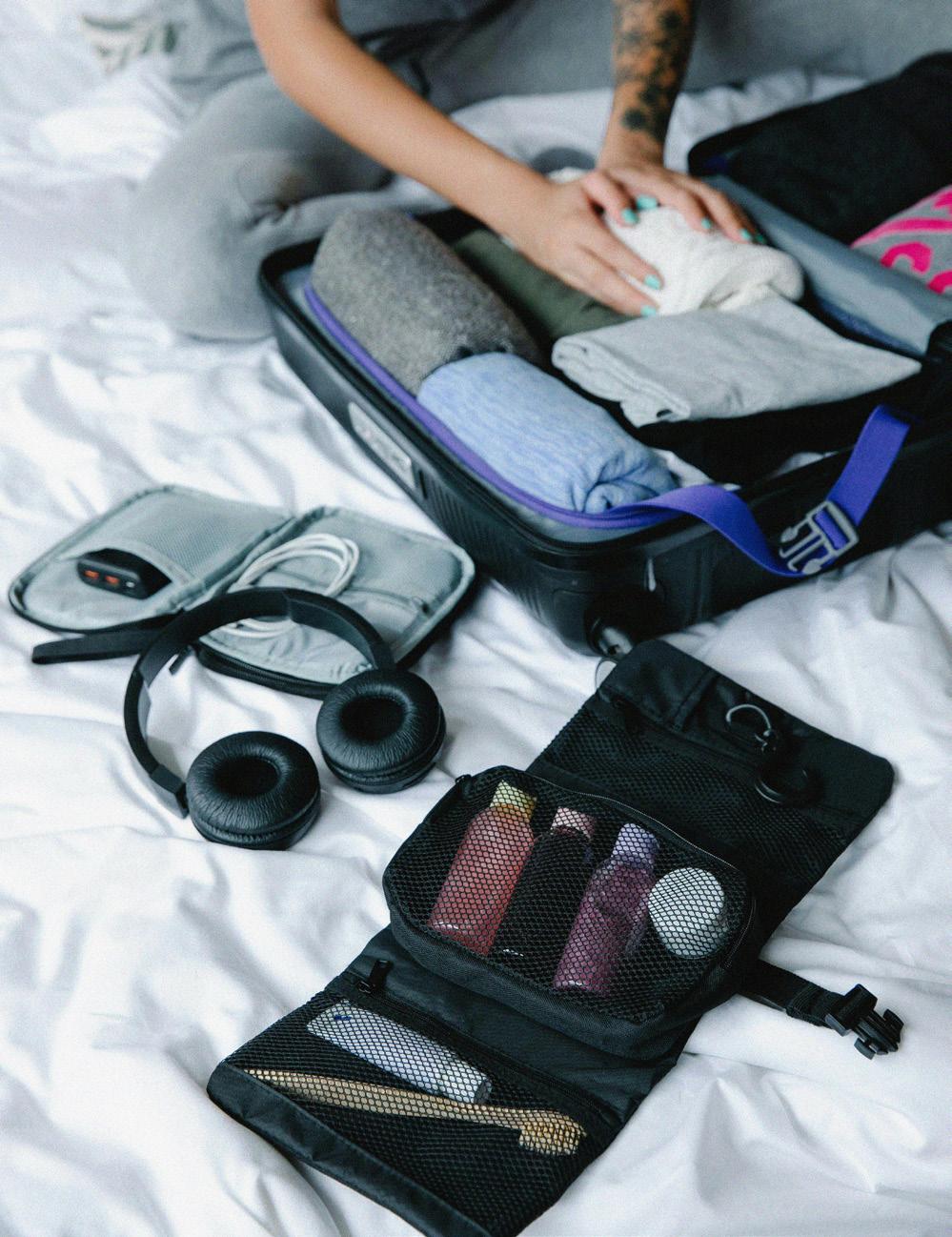

A huge amount of waste is generated by single-use plastic such as water bottles, bags, and hotel toiletries. Before you leave, consider filling up some reusable toiletry bottles with products you already have at home. Pack reusable bags for shopping trips, and a water bottle. The latter is particularly important, as tourists tend to drink more water than locals when travelling, particularly in warmer climates.
Try as we might, there is always going to be some degree of cost to our travels, which is why you may wish to consider offsetting emissions alongside taking
other actions to reduce your impact. Carbon offsetting refers to when you calculate the amount of carbon that you have created, and seek to equally compensate for those emissions elsewhere – usually through land restoration or planting trees.
There are many different sites and resources out there to help you make these calculations. One such organisation is Carbon Neutral Britain, which offers subscriptions for individuals who wish to become carbon-neutral. Of course, the best thing you can do for the environment is live and travel in a conscious way, but offsetting can be a great option for
those who want to go one step further.
If you’re keen to become an ecotourist you may find that your attention automatically focuses on your destination, and what you’re going to do while you’re there. But it’s worth considering what might be happening in your home while you’re away.
Unplug everything before you leave, and switch off appliances that you don’t need to run. Turn off the heating, or leave it on low if you’re away during the winter, and consider turning off the water to stop any dripping taps. With the peace of mind that everything back home is taken care of, you’re free to relax, explore, and learn (the eco way).

“Time moves slowly, but passes quickly
ALICE
How to deal with this common but awkward question when you’re not working
Writing | Kai ConibearYou don’t realise until you stop working just how much small talk revolves around what you do for a job. Strike up a conversation with someone, and the inevitable questions begin. They want to get to know you, and for some reason, it almost always starts with: “So, what do you do?” Or: “Where are you working at the moment?”
It’s a loaded question. That feeling of dread begins to creep over you. You make excuses for
not working, rather than telling the truth. Many people feel anxiety when work talk comes up in conversation. Feelings of guilt and shame rise to the surface. So, how can we deal with these feelings?
If you can’t work, or you’re taking time out, you shouldn’t feel ashamed. It means you’re taking your health and wellbeing seriously, and not working yourself into a potential crisis.
A few years ago, I gave up my full-time job as a family
worker for a local council. I was on sick leave for six months when I decided I was too ill to return, and resigned. I was later diagnosed with bipolar disorder. I was out of work for nearly two years, which crushed me. My work had defined me, and I was immensely proud of what I did, day in and day out. But what I realised was that working was detrimental to my health, and caused me to spiral further into a bipolar episode. Initially, I found it incredibly difficult to talk >>>
If you can’t work, or you’re taking time out, you shouldn’t feel ashamed

about not working. However, the more I did talk about it and why I was unemployed, the easier it became.
What to do if someone questions you about work
So, how do we go about answering this question?
As with any conversation, it depends on the circumstances and your relationship with the person asking. Never feel you categorically have to answer. It’s OK to move the conversation on to another topic, or simply
say you don’t feel like talking about work and jobs right now. I personally like to go with honesty, but if you’re feeling vulnerable or anxious, it’s reasonable not to answer. Most people won’t question you further, and will accept you don’t want to talk about work. For those that do, again, it’s fine to assert your boundaries, and ask to move the conversation on.
On the other hand, if you feel you want to answer, it’s best to be honest. Giving a vague answer invites more questions, so you’ll
end up saying more than you perhaps plan to. I would always go into these conversations thinking that if someone wants to get to know me, the real me, they’re going to have to understand that I am out of work at the moment. If I lie, it is only going to negatively impact my self-esteem. I’m only ever hurting myself by not being truthful.
It isn’t an easy approach, and many people find it stressful to talk about unemployment for fear of being judged. But
if someone judges you for not working, whatever your reasons may be, they’re not worth getting to know. They’re not worth investing your time in to. It may mean they need to reassess their priorities in life, and think about what makes them fulfilled and happy beyond their job.
A common feeling we have in response to this question is guilt. We feel guilty for doing nothing when, in reality, we are never just doing ‘nothing.’ It could be you’re volunteering or learning new skills at home or in the community. You might be involved in activism, or you’ve started a blog or newsletter. Even tasks that seem small to others might be massive accomplishments for you, and it’s OK to speak up and cheer yourself on.
If taking care of yourself is how you’re spending your time, then that’s perfectly valid. It’s also a good opportunity to introduce the person to a new book, new ideas you’ve read or listened to on a podcast, or a new hobby or skill. Steering conversations to what you’re doing with your time, or how you’re taking care of yourself, will make you feel more comfortable answering this question.
It’s also OK to be honest if you’re struggling. Being unemployed can impact our mental health, and it can feel like there are mountains of time
to fill each day. Talking to others can help, and they may have suggestions or know of groups and activities which happen during the day. It might also be that you’re off work due to mental and/or physical illness, and you don’t have the energy to be active or learn skills or hobbies. There should be no shame in simply taking care of yourself, however that may look for you, and sharing why you’re not working and what your day looks like, can open up conversations and support from others.
Now, I’m back in employment, but I don’t feel ashamed of the time I spent not working. It gave me space to spend time with family and friends, learn more about myself, passions I didn’t realise I had, and hobbies and skills I never knew I was capable of. At the same time, it gave me space to understand my illness, and the best ways to look after myself. I’d never had time to focus purely on my health and wellbeing before, and it helped me find better treatments and stability sooner than if I had been in work.
The overall takeaway here is that work doesn’t need to define you. There is more to life than a job. If you find yourself unable to work completely, it means you’ve been struggling for too long. Finding yourself without a job isn’t a sign of failure, especially in the current climate.
You are under no obligation to answer.
Steer the conversation on to other topics if you’d prefer.
If you’re comfortable, be honest with them.
Don’t feel guilty or ashamed. Share how you’re caring for yourself.
Remember your health and wellbeing is the priority –and that’s where your time and energy are going right now.
There are so many things that define a person – their hobbies, their passions, and their personality to name a few. It’s about changing our priorities and recognising what truly brings us joy and happiness in our lives, and leaves us with a feeling of contentedness. When we acknowledge this, it makes that question of ‘What do you do?’ less daunting, because we’ve realised there are a wealth of topics we can talk about more passionately, and with conviction.
Kai Conibear is a writer and mental health advocate. His first book, ‘Living at the Speed of Light’, about bipolar disorder, is out now.
When does an innocent crush become a destructive obsession?
Writing | Kathryn WheelerIt’s the big, life-changing, indescribable feeling – and it’s fair to say there’s a whole lot of myths surrounding love. Perhaps due to the fact that it’s so hard to put into words, and also that it can be such a uniquely individual experience and feeling, sometimes, we may not always be sure of precisely what’s going on in our hearts and minds. Is it love or is it limerence? It may be a question you’ve asked yourself at some point, or one you’ve wondered about a friend who has fallen head over heels for someone they’ve only just met. The difference is key, and being able to make the distinction could both save a lot of hurt, and open up a new window into selfunderstanding.
You may be familiar with the idea of a ‘hopeless romantic’, but limerence is far more destructive than that. It describes the experience of having a longing, or sometimes an obsession, with
another person, usually without the feelings being reciprocated. It’s different from lust in that it is often much more than a physical attraction, with the individual putting the object of their affection on a pedestal and overestimating their positive characteristics – but it’s also different from love as it is mostly constructed via fantasy and longing, rather than on genuine connection and real attributes.
In 1979, in her book Love and Limerence, psychologist Dorothy Tennov coined the term after conducting interviews with more than 300 participants. Tennov did not believe that limerence was a pathological condition, and felt that it was an experience healthy individuals could go through, and then return to normal.
However, in 2008, psychologists Albert H Wakin and Duyen B Vo returned to Tennov’s research, and proposed parallels
between limerence and obsessive compulsive disorder (OCD), as well as substance use disorder –though maintained that limerence was a separate condition. More recently, there has been some debate around this position, with some experts arguing that, as limerence can interfere with our day-to-day lives, it should be considered a psychiatric condition, and added to the Diagnostic and Statistical Manual of Mental Disorders.
On the online forum platform Reddit, the subreddit r/limerence is a space for those who experience limerence to come together for support and information. Often sharing their experiences with the ‘LO’ (an abbreviation for ‘limerent object’ – the person they are infatuated with), many lament the lack of formal recognition, as limerence has a devastating effect on their relationships, health, and wellbeing.



It’s thought that there are three stages of limerence:
• Infatuation: When you are first drawn to the person and begin your admiration.
• Crystallisation: When those thoughts and feelings become obsessive, often combined with anxiety.
• Deterioration: When the limerence wears off.
Dorothy Tennov proposed that limerent episodes may only happen once in a person’s lifetime, with the average episode lasting between 18 months and three years. These periods can be accompanied by other mental health problems, such as anxiety and depression.
Andrea Tibbitts is a specialist relationship therapist, and she recognises just how destructive limerence can be.
“Limerence is painful. In the midst of it, you are a prisoner to your longing,” she explains. >>>

a desperation to be with another person. You have an insatiable obsession to pursue them because they are your ‘ideal’. Being constantly consumed by thoughts of them, you are captive to your fantasies. You have this ache on the inside to just be with them, that you ‘need’ the object of your limerence to complete you. It is as if this is the one person that you need to survive, ‘the one’ you have been waiting for, before you even know them…”
Andrea goes on to explain how the drive to ‘have’ the OL is so strong that healthy functioning can be affected, and the individual can go on to make reckless decisions, as well as neglecting their needs.
There is also some speculation that limerence is related to attachment disorders, specifically in those who have negative experiences with caregivers in early childhood, and who also perhaps experience separation
anxiety. Considering the possibility of this link, the pain of limerence is clear to see.
“Real love can also, of course, be heady,” explains Andrea. “However, love is based on connecting with someone in a real and meaningful way, and not just our perfect projection from a distance of who we need them to be. Love carries a curiosity to get to know the other person, to explore their world, so that the two of you can be on the journey together, without you sabotaging or losing yourself.”
So, how can a limerent move forward?
“We know that love and fear are opposites,” says Andrea. “Fear never makes a good leader for us in relationships, so the more love we can feel in the rest of our lives, the more secure and stable we will be in romance.
“Create a base of healthy friendships, so that your love tank can be well filled. You are more at risk of limerence and emotional pain if you go into a relationship running on empty. Identify where your vulnerabilities are. Seek to be proactive in creating strategies to protect yourself, and build yourself up in those places. We all have fears, but if we take care of them they do not get into the driving seat. Focus on how you can meet your own needs, before looking to a partner to meet them all for you.”
Above all, Andrea advises being good to yourself, explaining that the kinder and more
compassionate you are to yourself, the more your nervous system will experience psychological safety –meaning it will then be less likely to be triggered.
“Kindness and respect pave the way for love,” she continues. “Be intentional about leading with those in all your interactions. Then you will be better attuned to when you are encountering the opposite.
“Develop your emotional language and self-regulation, so that when that right relationship comes you are already prepared. Practise taking responsibility for yourself by using ‘I’ statements, and expressing what you think or feel. You will show up as the best version of yourself, and your future partner will thank you for it!”
Limerence can be a deeply unsettling experience, but what is clear to see is that it typically has layers, and often a history. If this is something you have experienced or are currently experiencing, go easy on yourself, and be comforted by knowing you are not alone. But recognise that there is support out there for limerants – be that online communities who ‘get it’, or mental health professionals – and, with time, you will figure out how to move forward.

Andrea Tibbitts is a specialist relationship therapist, passionate about restoring harmony. Connect with her on the Counselling Directory.
Spend some quality time exploring the following question prompts with your significant other to deepen your connection
How do you like to express love?
How do you like to receive love?
When you’re upset or hurt, how would you like me to support you?
What does trust mean to you?
Is there a moment you feel really demonstrates this for us?
Is there a time when you felt trust was tested, and what could have been done differently?
Can you describe an event in your life where you felt like your trust was broken?
How did this impact you moving forward?

What areas of trust do you think we need to work on?
When we have conflict, do you think we communicate well?
What could be improved?
Do you think we show each other enough appreciation in our relationship?
Can you describe a time when you truly felt seen in our relationship?
From setting reminders to making adaptations that suit you, eating well is often about honouring your needs
Writing | Lydia WilkinsNeurodiversity is an umbrella term for a wide range of conditions such as autism, ADHD, dyspraxia, and others. For some people, there will be more than one ‘label’ present, meaning that someone’s needs may overlap.
I live in two worlds. I’m autistic, but I also function as a journalist. During the first Covid-19 lockdown, I was curious about stories that talked about a rise in eating disorders. But there wasn’t a lot of information about the link between eating disorders and autistic women, like me, who are usually diagnosed later on in life. I spent a long time researching the various lockdowns, and eventually wrote an award-winning book to open up the kitchen to neurodiverse people.
These are the basic ‘hacks’ everyone should be equipped with in order to eat well with neurodiversity.
Set up a ‘hydration station’
Sometimes a neurodivergent person, particularly an autistic individual, may struggle with interoception issues; the key sense allows us to interpret
sensations in the body, such as if we are thirsty, hungry, have hurt ourselves, etc. Not knowing if you are hungry or thirsty can have a knock-on impact on your mood, physical health, and mental health over time. Try setting up a ‘hydration station’ to have an easily accessible bottle of water within eyeshot. If you need to commute, stock up on liquid to take with you.
Make time visual Neurodiversity sometimes can come with executive functioning struggles – this is a set of skills every person has, that enables us to execute a task. If this sense is impaired, it can have a knock-on impact, such as when trying not to burn food when cooking and completing tasks. Think of making a sandwich and all the steps. All of them have to be sequenced to get to the final stage, and it’s a lot! Making time visual can help, such as when it comes to using timers on your phone, or even specialised apps such as Tiimo to help plan out your tasks. It can keep you on track if you’re prone to stopping tasks part-way through, and can also help you to avoid overcooking.
Think about physical adaptations that can be made
Society has a point of view that we all have to achieve the same expected standard, or we are somehow ‘giving in’ to whatever can cause us to need help. This is an outdated view, and can actually be harmful, because sometimes we all need help to carry out tasks. Think about physical adaptations that can be made in the kitchen. This could be something such as a jar opener, weighted cutlery, or a plate separator. A jar opener is about £2 online, but it saves the huffing and puffing of unscrewing a lid, and it supports those who may struggle with motor skills. Weighted cutlery may also do the same, and a plate separator is ideal if you have sensory issues, as it separates food into categories. They are cheap adaptations to create a state of equality in the kitchen.
Designate a meal to a shelf in your fridge
Take a shelf in your fridge, and designate it to a meal type: breakfast, lunch, dinner, and (possibly) snacks. Allow yourself

to set up for the following week with the designated ingredients per shelf, for all meals. It saves space, can help with feelings of overwhelm, you can ‘grab to go’ if you need to leave suddenly, and this form of meal planning is also a great way to budget.
A smartphone can set daily reminders to act as a ‘prompt’, such as to eat, drink, take medication, etc. Having a designated mealtime will mean there is less of a chance of forgetting to eat, and it can be used to help manage other things, such as if you need to take medications with food.
If you’re a young adult who is living by yourself for the first time, and struggling to maintain a routine, or you have caring responsibilities that take up a lot of time, it’s important to put fuel in the tank regularly to stay on top of things.
Every neurodivergent person is different, with their own needs and accommodations they require. But eating well is something we all deserve, and we can ensure that by making the kitchen a more accessible space.

QRegistered nutritionist VJ Hamilton answers your questions on managing arthritis.
What is arthritis and how can nutrition help?
AArthritis is a chronic inflammatory condition characterised by swelling, stiffness, and pain in the joints. It often results in limited mobility,
QI’ve heard it’s important to eat right for specific types of arthritis. Is this true?
AYes, it’s true. Different types of arthritis may benefit from alternative dietary approaches, and that’s because they each have their own unique underlying causes. For example, rheumatoid arthritis (RA) is an autoimmune
and deterioration of joint cartilage and surrounding structures.
Nutrition can play a crucial role in managing arthritis, by reducing inflammation, and providing the essential nutrients which are critical for joint health and repair. Proper nutrition can help
manage arthritis symptoms on a daily basis by eating foods that reduce inflammation, and prevent further joint flare-ups. A healthy diet can also boost mental wellbeing, which can help someone living with arthritis feel better day-to-day.
disease, so nutritional strategies for RA often focus on reducing inflammation and supporting the immune system to manage symptoms. Whereas, with osteoarthritis characterised as a breakdown in cartilage in the joint, foods rich in antioxidants and nutrients that support joint health, like vitamin C and collagen, can be beneficial.
Gout, which is caused by the buildup of uric acid crystals in the joints, is linked to high purines in the blood. Therefore, limiting purine-rich foods (like red meat, organ meats, and shellfish) and alcohol can help reduce the risk of gout attacks.
However, in clinical practice, the dietary recommendations often overlap, as all types of arthritis are linked to inflammation.
Read more about VJ on Nutritionist Resource.
QAre there any foods that should be avoided for people with arthritis?
AYes, certain foods – such as highly processed foods high in refined sugars, saturated fat, and trans fats – may contribute to inflammation, and worsen arthritis symptoms. For those with gout, red meat and organ meats contain high levels of purines, which can increase uric acid levels in the body and exacerbate symptoms. In addition, some evidence suggests that people with arthritis, particularly rheumatoid
arthritis, may experience increased inflammation from nightshade vegetables, like tomatoes, peppers, and aubergines, due to the compounds they contain called alkaloids, particularly solanine and capsaicin. Most of the evidence to support this is anecdotal, but I have seen some clients see better results when they remove nightshade vegetables from their diets.
VJ’s top tips for managing arthritis day-to-day
• Move throughout the day. This helps lubricate the joints, maintain flexibility, and strengthen muscles, reducing strain and inflammation.
• Eat three different coloured plant-based foods with every meal. This ensures a diverse intake of nutrients and antioxidants, to reduce inflammation and support joint health. Different coloured fruits and vegetables contain various vitamins, minerals, and phytonutrients, each with unique anti-inflammatory and antioxidant properties.
• Incorporate deep breathing exercises to help reduce stress and promote relaxation, which can alleviate muscle tension and improve circulation.
• Meal prepping can be incredibly beneficial by reducing the physical strain and stress associated with daily cooking. By preparing meals in advance, you can minimise the need for repetitive motions and prolonged standing in the kitchen, which can exacerbate joint pain and fatigue.
• Stay hydrated. Keep a water bottle with you throughout the day and sip regularly to stay hydrated. Herbal teas and infused water with cucumber or citrus slices can add flavour. Hydration is crucial for those with arthritis, as it helps maintain joint lubrication and flexibility, reduces inflammation, and supports overall health.
As much as we’d all love to sail through life on calm seas, almost all of us will encounter storms from time to time. These storms can take many shapes, including traumatic experiences.
When something happens to us that feels very distressing, frightening, and/or out of our control, it’s called a traumatic experience, and, sadly, many of us will experience some form of trauma in our lives. For some, the effects of this can linger and turn into post-traumatic stress disorder (PTSD). This means that even though the trauma is in the past, you can be triggered into feeling like you’re re-experiencing the event in the present.
In order to understand what can help us cope with trauma, it’s helpful to recognise how trauma affects the brain.
“What happens when we experience a traumatic event is our cognitive processing system gets overwhelmed; the memory gets stuck in the amygdala,” Dr Joe Barker explains on ‘Happiful’s’ podcast episode, ‘Finding What Works: Coping with Trauma’.
“What that means is it gets stuck as something which is happening in the present. When we experience something in the present that lines up with that memory, it re-triggers it, and we almost go through it again.”
Essentially, our brain struggles to process what’s happening, and stores the memory in an unhelpful way. Coping with trauma is therefore often a careful balance of finding a way to process the memory so it can be stored better, and managing any experiences of being triggered.
With that in mind, let’s explore some effective ways to both process and cope with trauma.
Ideally, the first port of call when you’re struggling with trauma is to work with a professional. The two therapies recommended by national guidance for trauma are eye movement desensitisation and reprocessing (EMDR), and traumafocused cognitive behavioural therapy (CBT).
Both use different approaches, but their aim is the same – to help the memory move from the amygdala through to the hippocampus. The therapies do this by gently taking you back to the traumatic experience, and helping you to process it in a safe environment. While these two are the only ones currently recommended by national guidance, Joe notes the
importance of taking control of your own healing journey, and finding what works for you.
“Different people have different experiences of trauma, and different experiences of their healing journey,” Joe says. “Trauma therapy in general is actually around empowerment and regaining control – winning back aspects of our lives. There are all sorts of different things which individuals might find helpful that sit outside those two nationally guided therapies.”
Another avenue you might want to consider is the creative arts. Sometimes putting words to the trauma you’ve experienced feels too difficult. Artistic approaches like painting, music, creative writing, drama, or dance can help you look at your experience from a distance.

You may choose to do this work with a professional who offers trauma-informed arts >>>
Hear more from Dr Joe Barker and Sarah Wheeler on how trauma affects the brain and how we can cope, by listening to our podcast, ‘Happiful: Finding What Works’.
therapies, or you could have a go yourself at home. This will depend on how confident and comfortable you feel exploring these emotions alone. Try:
• Using colour and shape to create a visual representation of a challenging feeling. Can you identify any hidden messages here?
• Making a calming playlist that helps you feel safe.
• Writing a letter to your past self, talking about all of the lovely things you’ve experienced since the trauma.
Hypnotherapy is an approach that works with your subconscious through deep relaxation. In this trance state, a hypnotherapist can help you process past traumas, and any unhelpful behaviours that stem from it, safely. Similarly to other therapies that help with trauma, hypnotherapy can support you by changing the way memories are stored, and altering your reaction to triggers. While more research is needed before it is recommended by national guidance, a 2016 meta-analysis, published in the International Journal of Clinical and Experimental Hypnosis, found evidence that hypnotherapy can be effective at alleviating symptoms for those with PTSD.
Grounding exercises utilise mindfulness to help you connect with the present moment. This can be incredibly helpful when
coping with trauma, as triggers can often send you back in time, emotionally, to the traumatic event. Grounding exercises root you to where you are in the moment, and can help your body come back into a state of calm. Try these techniques:
• Keep a grounding talisman with you, such as a rock with uneven textures. When you feel triggered, hold on to your object, and focus on how it feels in your hand, while taking slow, deep breaths.
• Use the 5-4-3-2-1 technique. List five things you can see, four things you can feel, three things you can hear, two things you can smell, and one thing that you can taste.
• Keep an aromatherapy rollerball with you, and use it to activate your sense of smell.
• Eat a strong mint to activate your sense of taste.
Somatic experiencing is a particular therapeutic approach that considers how trauma can be stored in the physical body, and uses techniques to release it. As somatic experience recognises, connecting with your body is often an important part of trauma recovery. This is all about feeling safe in your body, and finding a way to regain control you may feel you’ve lost through the trauma. Mind-body practices like yoga, tai chi, and qigong can help with this.
Another guest on our ‘Finding What Works: Coping with Trauma’
episode, yoga teacher and sexual assault survivor Sarah Wheeler, explains that, at first, she found yoga difficult.
“I found it hard to be still. I found it hard just to take up space and be where I was,” says Sarah. “So much of yoga, when it’s taught in a kind, curious, and laid-back kind of way, is really about embodying; embodying who you are, and embodying who you are from moment to moment. It’s about acceptance – yes, I found downward dog hard today, maybe I’ll find it easier tomorrow. Even if I haven’t, I can continue to accept where I am.
“When we connect with the inner world, we don’t have to be so spun out by everything that’s very much an outer experience.”
The trick here is to go slow. Look for teachers who are traumainformed, and listen to your body if something doesn’t feel right.
However you decide to approach your healing, know that you’re not alone on your journey. None of us can control the storms we have to weather in life, but there are tools available to help us rebuild and keep sailing.

is
psychologist. Get in touch via the Counselling Directory
Visit the Therapy Directory for more.

From a life-affirming story about three dads connected by grief to a green guidebook for flight-free travel, we share four books worth reading
Writing | Lauren Bromley-BirdThree dads, one remarkable mission. In 2021, Tim, Mike, and Andy set out to walk 300 miles across the UK, after each having lost a daughter to suicide. United by loss and shared grief, they took on a challenge of a lifetime,

Is Why You Dream by Rahul
JandialEverything you’ve ever wanted to know about dreaming can be found within the pages of this fascinating book. Neurosurgeon Rahul Jandial dives into how our dreams can impact our waking life; from how dreaming of an exam can help boost your performance to how dream disorders can warn you of possible diseases.


Three Dads Walking: 300 Miles of Hope by Tim Owen, Mike Palmer, and Andy Airey determined to raise awareness of suicide prevention, and to walk in memory of their cherished daughters – Sophie, Beth, and Emily.
You can read about their honourable journey through their book, which details diary entries of their own personal

Productivity: How to Do More of What Matters to You by Ali Abdaal
Productivity expert Dr Ali Abdaal has found the secret that offers a new perspective on the hustle culture, and it’s not found in working yourself into the ground. What it’s actually about is making your work feel good. If you’re ready to flip the game on productivity, so that you can throw your all into something without sacrificing your own happiness, this book is for you.
experiences of grief, and how they continue to find hope through the darkest of times.

The Flightless Traveller: 50 Modern Adventures by Land, River and Sea by Emma Gregg
The Flightless Traveller is the go-to guidebook for those who want to explore the world while keeping the planet in mind, and are conscious about going flight-free. Filled with 50 voyages by land, river, and sea, find out which eco-friendly city break or coastal retreat is just the ticket for you.
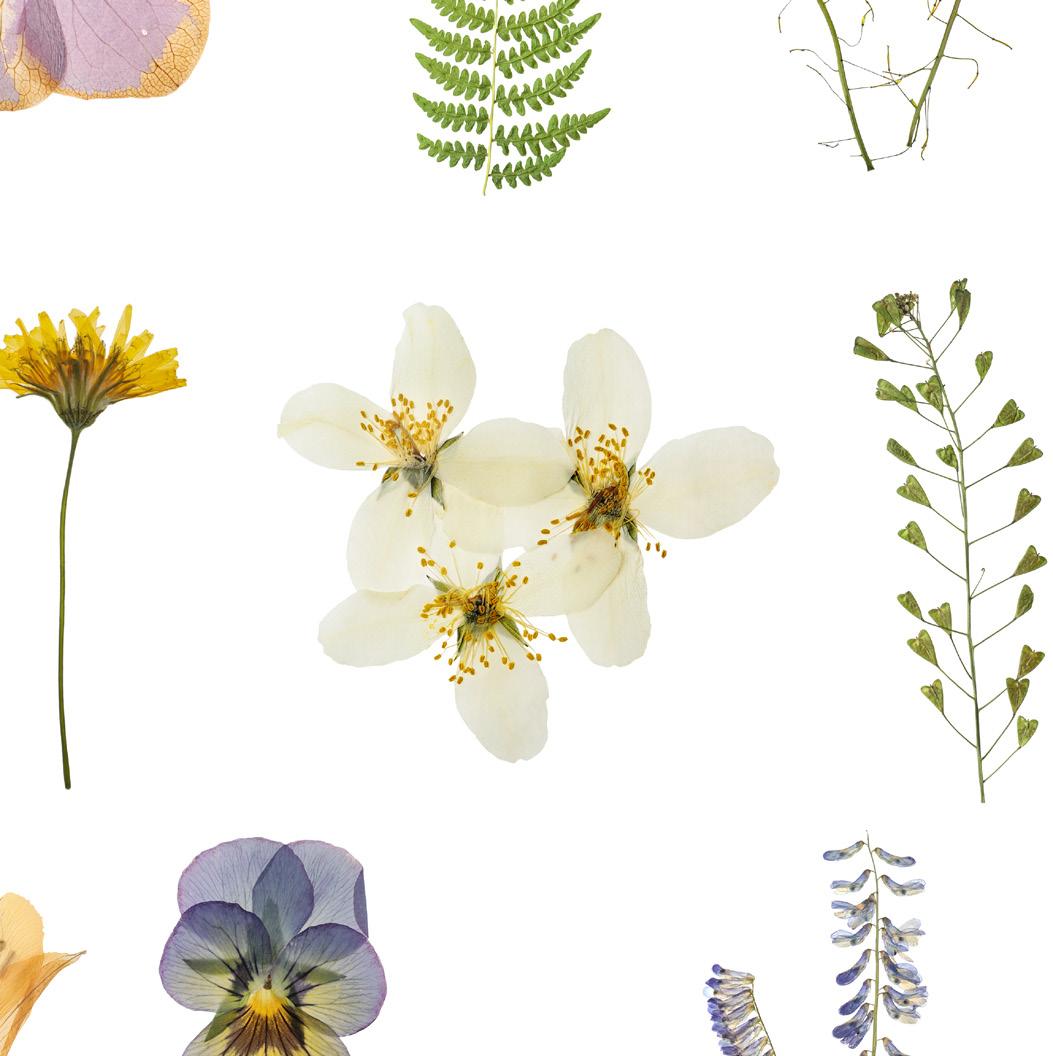


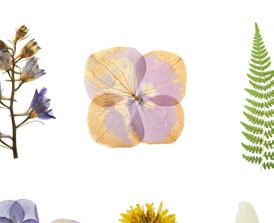
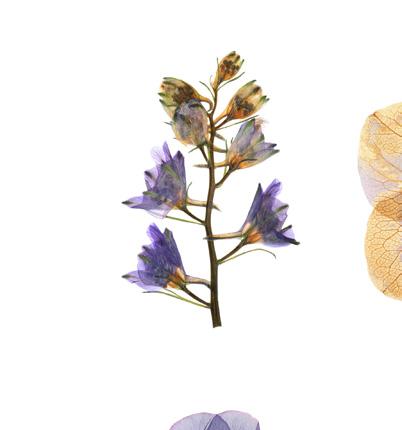
take a sip of my tea, and stare out at the scene: the colourful, wooden rowing boats bobbing on the lake, contrasting the various green hues of the mountains reflected on the rippling canvas of the water. I breathe in the sweet smell of grass and flowers lingering in the air. Geese honk in the distance, and a stream rushes nearby. There is the sound of other people at this lakeside café, chatting softly, punctuated by the occasional clatter of a teacup. Gazing out as I sit at this wooden picnic table, I feel so calm. I could happily stay here all day. My notebook and pen are in front of me, and, over the course of an hour, I write pages and pages.
I’d been feeling in a bit of a creative rut, so having the words flow is very welcome. Being in nature can be a brilliant way of kindling our creativity. Sometimes, our art can be directly inspired by what we observe – sketching a sparrow perched on a branch, or penning poetry about a beautiful view. But being in nature can also help spark our imagination even if what we’re working on has nothing
to do with the natural world. I find going on a walk, even just a 20-minute lunchtime lap around the block, can help me come up with ideas, or think through a problem, and I return to my desk feeling refreshed.
“When we are in nature, creativity is all around us, and there is something for all our senses,” says life coach Ingrid Van Oostrom. “Nature is rich in symbolism. For example, when you are going through a challenging time in life and you sit at the edge of a flowing river, thoughts of the flow of life might come up, knowing that challenges come and go. Or when looking at a growing tree you might appreciate the resilience of your body, mind, and spirit.”
Being at one with nature can support our wellbeing and help us reconnect with ourselves, too. “Taking a moment to appreciate and connect with nature brings peace,” Ingrid says. “It calms us, and can give us many insights. Many artists head into nature to escape the distractions of daily life, to connect with themselves and the world around them. When we are able to disconnect from


modern life and technology, and truly connect to nature, that is when creativity flows, as we are surrounded by it.”
You may well have experienced how spending time in nature can help ease difficult emotions. We can combine this calming benefit of nature with a creative outlet.
“Using creativity is a great way to release negative emotions,” explains Ingrid. “For example, when being frustrated, going out in nature clears our mind, which then allows us to use a creative activity to release that frustration. Imagine painting dark clouds with the sun in the background, or journaling out pent-up thoughts.”
We can use nature as a way of tapping into how we feel. Sometimes, I find that the sense of awe of being in nature can make me want to put pen to paper to capture how I feel, and to reflect on my life.
If you want to give it a go yourself, have a think about what has


inspired you in the past. Are you moved by a sunset, or the sound of the dawn chorus? Do you feel free swimming in the sea, or wandering through a woodland? And while travelling to a well-known beauty spot can be worthwhile, it’s good to think about ways you can connect with nature close to where you live, rather than waiting for the ‘perfect’ place.
“It starts with awareness, like most things,” says Ingrid. “Be present and use the senses to ground yourself. Look at that view, feel the earth beneath your feet, smell that smell. What does that bring up for you? Being at the beach when it is windy might inspire you to run along the shoreline, or dance on the sand creating funky shapes.”
If you aren’t sure about what creative activity to use, it can help to get in touch with what you’ve enjoyed in the past. Says Ingrid: “Which sense do you connect with most? If you are a visual person, then you might love to paint, or draw, or take photos, or experiment with natural dyes. Maybe you connect to sound? Then you might like to record birdsong or the sound of waves or wind for a musical piece, or use it to sleep at night. If it is touch, what about walking barefoot, planting plants in your garden, or practising yoga or hugging a tree? Listen to your intuition.”
You might want to bring something like a notebook or sketchbook with you, or even make notes or take photos with your phone (I’d recommend


Ingrid Van Oostrom is a life coach helping you to feel confident, empowered, and able to face life head-on. Visit the Life Coach Directory to discover more.
switching off notifications or putting your phone on aeroplane mode so you aren’t distracted when using it). But you may also find that you don’t need any materials – that just being in nature is enough. Sometimes, it can help to go with a gentle sense of purpose, but it’s OK to just let yourself go with the flow and not set big expectations. For me, finding somewhere comfortable to sit with my notebook and pen, whether perched on a rock or at a picnic table by a lake, is the perfect way to be inspired by nature.

“None of us can know what we are capable of until we are tested
BLACKWELL
Giving back to good causes can come in a multitude of ways. Here’s how to make volunteering work for youWriting
| Laura Cooke
It is universally accepted that volunteering is a good thing that helps to make the world a better place. The act of giving up your time and drawing on your skills to help a good cause not only benefits the organisation involved, but it can also boost the confidence and the mental and physical wellbeing of those who do it.
Yet, for some, volunteering can feel like a daunting prospect. Physically going out to volunteer may prove difficult if you have limited mobility, or live in an area with poor transport links. Inflexible hours can also be a barrier if you have childcare considerations.
But these barriers are not insurmountable, and there are ways to make volunteering work for you.
“There’s a huge spectrum of volunteer roles available,” says counsellor Georgina Sturmer, who has worked in charity recruitment. “This means that the possibilities are endless. But it can also mean that the choices feel overwhelming or confusing.”
Georgina – who has previously volunteered as a trustee, a counsellor, a school governor, a helpline volunteer, and a homevisiting volunteer – says before you start searching for the perfect role, you should explore your motivations for volunteering to give yourself a clearer idea of what you want to gain from the experience.
“There’s a misconception that volunteering should always be driven by altruism. It’s absolutely the case that we are often driven
by wanting to do something positive or helpful, but there are lots of other reasons that might motivate us to volunteer. And the truth is that most charities will embrace this,” says Georgina.
“The more motivated and engaged you are as a volunteer, the more likely you are to be committed to the task that you’re doing – so it’s a real win-win. With this in mind, think about what you stand to gain from your time as a volunteer. Maybe you want to get out of the house more, spend time in a different environment, develop a new routine, meet new people or gain new skills. Take account of this when you are thinking about what role to take on.”
The next step is choosing where to volunteer, although there may >>>

be practical considerations about location or availability. Some organisations may be willing to adapt to remote working or flexible hours, or there may be alternative roles available that may be better suited to you, so it is worth having a conversation when you find an organisation you’d like to be involved with.
“It’s worth thinking about whether you’d like to be involved with a major national charity, a small local organisation, or something in between,” adds Georgina. “Some charities might operate under a nationally known ‘brand’ name or federation, but in practice they might look and feel like a local organisation.
“You’ll also want to think about the type of cause or campaign that fires up your passions. There is a charity or campaign for almost every interest and every sector of our community:
children and young people, housing, education, international development, healthcare, wildlife – the list is endless.”
For Lydia, she chose to become a listening volunteer at Samaritans after experiencing difficulties with her own mental wellbeing in the past.
“I answered calls, emails, and text messages from people who just needed someone to listen,
without fear of judgement,” she says. “I found being a listening volunteer hugely rewarding, although the nature of the role meant it certainly wasn’t easy.”
Lydia was working in a fulltime admin role, travelling straight to work to her local branch for volunteering sessions on a Friday night, sometimes into the early hours of Saturday morning.
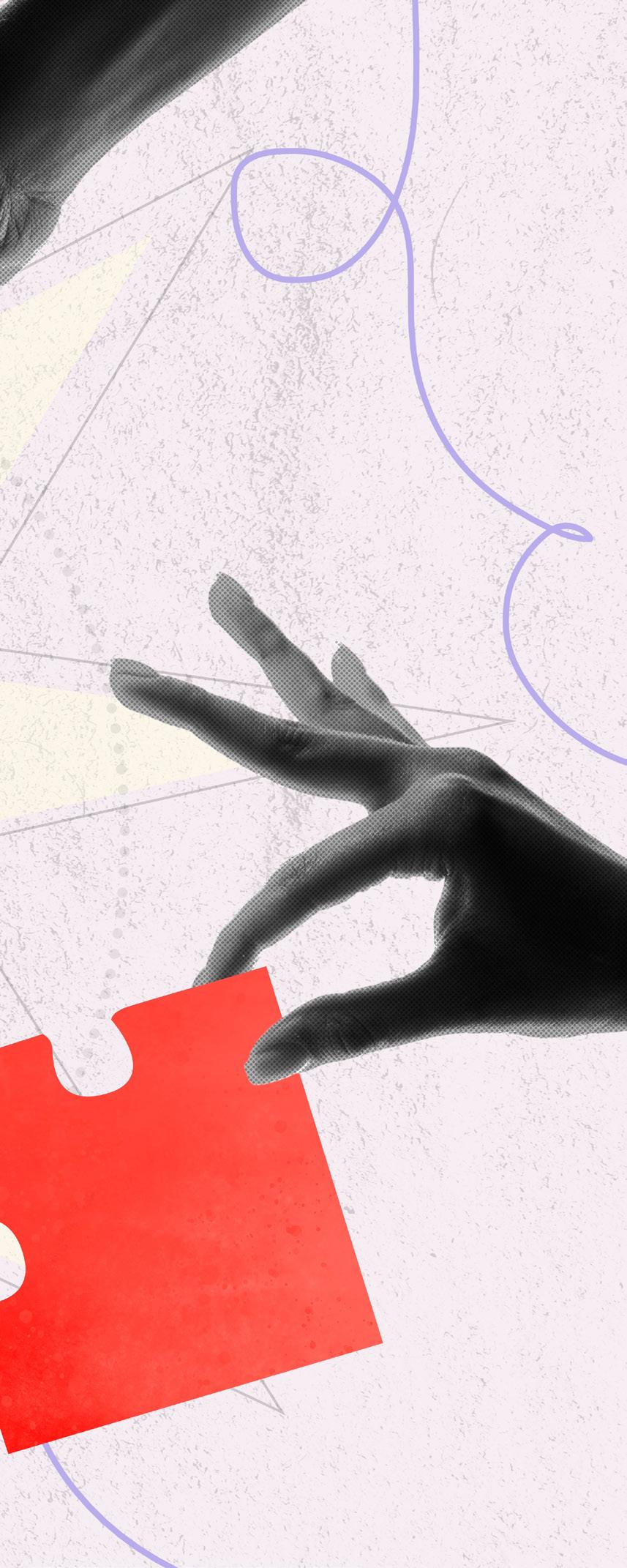
But after three years, Lydia experienced some health issues, which ultimately caused her to go into premature menopause in her early 30s.
“I was lucky that there were no physical symptoms that prevented me from going to the branch and sitting through a shift, but eventually, the mental impact of this major, and unexpected, life change took a
toll,” she says. “My moods and emotions started to become more up and down, and I felt unable to support the callers as I had done previously. I also felt very fatigued, and the thought of a midnight to 3am shift at the end of the working week just felt way too much for me.”
Rather than leave Samaritans, Lydia took a six-month sabbatical before returning in another role.
“After much soul-searching, I decided that I didn’t want to return as a listening volunteer. It was a difficult decision, but one that was right for me,” she recalls. “I wasn’t ready to walk away from Samaritans, so I spoke to the branch director about what I could do behind the scenes, and took on a role as branch fundraiser, working remotely, to my own schedule. And I loved it. It gave me an enormous sense of satisfaction knowing that I was helping to support my branch and the volunteers on the frontline.”
Lydia found a volunteering role that worked around her health issues, and it is important to remember when you are considering volunteering that there are roles out there that will fit in with your own personal circumstances.
“When choosing the type of role, consider whether you would like to be at the ‘coalface’ of a charity’s work, delivering services directly in the community, or would you prefer a more managerial, fundraising or administrative role,” says Georgina. “This decision might be driven by where you are at in your life and career.
• If you have a specific charity in mind, check out their website for available positions.
• In the UK, visit doit.life to browse 1 million+ volunteer opportunities.
• Aged 14–30? Look through the vinspired.com platform.
• For those with professional experience, reachvolunteering.org.uk connects you with charities in need of project or ongoing support.
Perhaps you want to develop your work skills, or continue to use them in retirement. Or perhaps you’d like a total change from the skills you’ve been using during your career.”
When applying for a volunteer role, it’s important to be realistic about the level of commitment you are able to give. “Many charities are ideally looking for volunteers who can offer a regular commitment at a fixed time. This might not be an option for you,” adds Georgina. “It’s useful to look specifically at the level of commitment that a charity is looking for. It’s always worth asking whether they can be flexible, if you need to arrange things around your other commitments.”
Wherever your volunteering journey takes you, it is important to look after your mental and emotional wellbeing to ensure that the experience is a positive and fulfilling one. This includes asking for help where needed. As Lydia says: “I am so grateful I had that breathing space to allow myself to focus on my own mental health. After all, you can’t pour from an empty vessel.”
Working out isn’t reserved for a certain type of person or body. Here, columnist Michelle Elman highlights the ways gymtimidation can get under our skin, and, crucially, how to reclaim our right to exercise
Writing | Michelle ElmanWhile I’ve been working out regularly since I was 19 years old, people are often shocked when I say this because I do not have the stereotypical ‘gym body’. But the truth is there is no such thing as a ‘gym body’.
This societal judgement is often a key component in why people can be put off exercising, or feel intimidated and unwelcome in the gym – AKA ‘gymtimidation. We have been taught that one of the main reasons to move our body is for aesthetic results, and so when someone like myself says they work out, it often comes with the assumption that you must either be lying or doing it wrong in some sort of way.
This can present itself in subtle and insidious ways; it might be when I’m doing an exercise in the gym, and someone will walk over to offer unsolicited advice assuming I’m inexperienced. Or, for example, when I was doing a personal training session with a new instructor who asked me to do an exercise, and when I said I couldn’t, told me that this was the kind of attitude that would get
me nowhere. They had clearly made assumptions based on the stereotype that ‘fat means lazy’, and leaned into it without stopping to ask why I said I couldn’t.
In this instance, the reason I couldn’t do that exercise is the same reason I started exercising in the first place. I’ve had 15 surgeries in my life – from dealing with a brain tumour to punctured intestines, obstructed bowels, and a cyst in my brain – and there are ways I am limited in the exercises I can do. I couldn’t do a plank because my stomach had been cut into 15 times, and with such extensive abdominal surgeries, when I do a plank, my shoulders take the burden which leaves me in pain.
I know my body, and over the years have learned to advocate for it in order to not cause injury, but it still frustrates me that we push this narrative of mind over matter, rather than listening to our bodies. Advocating for your body is the first place to start overcoming gymtimidation. Instead of internalising the messages of society, or listening to people who might make comments about the
way you work out, I want you to start thinking: ‘How dare you?’ How dare you judge me when you have no clue what I’ve been through? How dare you judge me when you have not lived a day in my life? How dare you judge anyone for trying something new, and thinking you are superior simply because you might have more experience, or because you grew up in a world where your body type was more accepted? I’m not saying that you have to vocalise it, but when you think ‘How dare you,’ it swaps from internalising their opinion to questioning it.
When someone approaches me in the gym and corrects me, or makes a comment on the way I am working out, the message that I keep at the forefront of my mind is that it is their projection, and it is usually an indication of their relationship with exercise, more so than me specifically. At the end of the day, if you pay for a gym membership, you are entitled to the space in the gym as much as the next person. You do not need to be a certain size or aesthetic, or be an expert on

all the equipment, to belong, because it is not their space to declare whether you are welcome or not.
Gymtimidation arises when we feel insecure, and allow this to dictate where we can go, what we should be doing, and whether we have the right to take up space. Within the gym, that can be apologising if you take too long on a machine, or moving out the way because, unconsciously, you believe someone else’s workout is
more important than yours. Take your time, and take your space –they can wait. You deserve to be able to move your body at your own pace.
The largest issue with gymtimidation is it takes away from the joy of exercise. We get consumed by fear, and spend the time there worrying about what other people are thinking about us as opposed to how we feel.
The best way to counteract this is to start questioning all the rules or
Advocating for your body is the first place to start overcoming gymtimidation
unspoken messages you have been taught around exercise. Detach it from nutrition, and compensatory behaviour around food and diet culture. You do not need to work out for an hour for it to count. You do not need to keep doing an exercise if you hate it. You are allowed to take breaks. Moving your body at home or in your job is just as valid, and the gym is not the only place that moving your body counts. A chilled workout is just as important as a high intensity one, and the best exercise for you is the one you love the most.

Michelle Elman is an author, TEDx speaker, and five-board accredited life coach. Follow her on Instagram @michellelelman
It’s natural to want to shield children from bad news, but sometimes we need to have tricky conversations. Whether it’s unexpected news or ill health, sharing difficult news is never easy, but here are five tips to help you navigate it…
Writing | Jenna FarmerWhen it comes to parenting, the thought of upsetting our child by sharing bad news can be hard to bear. As much as we want to make their world as care-free as possible, life can get in the way. Whether it’s change (such as a relocation or separation), illness, or even death, sometimes we have to have difficult conversations, whether we like it or not. While you might not be able to change the news or circumstances, you can change how you talk about it. Here are five tips to help you get it right…
1. Plan your words carefully.
Think carefully about how you deliver the news; you know your children best, so it’s all about making sure they can understand and process the information you give them.
“Use appropriate language and communication for the age of the child/children involved,” says therapist Fiona Van Zyl. “Deliver explanations using vocabulary they can access that is appropriate
for their developmental level. Being clear and concise is also important to avoid any ambiguity and misunderstandings, as these can cause additional stress for children.”
At the same time, stick to the key parts of the news. “Avoid overwhelming them with too much information,” adds person-centred counsellor Lianne Terry.
2. Model good coping strategies from the get-go.
Remember that your child is looking to you to understand how to express and cope with difficult emotions, so show them the way.
“Ensure that your child knows that they can express their feelings; children learn by example, so demonstrate healthy coping strategies yourself, through talking about and expressing your feelings, engaging in soothing activities, or seeking support from friends and family,” says Lianne. “Let your child know that whatever they feel is completely acceptable, and allow them to express their thoughts and feelings openly without judgement.”
3. Pick the right moment. There’s never a good moment to deliver bad news, but a little bit of planning can make a difference. It’s best not to blurt it out, but creating the best environment for sharing tough news can help.
“Create a safe space in which to share the news. Generally, this will be a quiet, comfortable space, where you can talk without distraction,” says Lianne. “Make sure you are completely in the moment with them, without feeling rushed or distracted.”
Therapist Fiona highlights how the setting for your conversation can play an important role, too.
“Consider the setting – a place that is familiar and where the child/children is/are likely to feel comfortable and safe. Bear in mind a routine that you and your children have when it comes to talking about things that are important to them. For example, if you often have conversations while sitting on the sofa, or in the garden and so on, it can be helpful to replicate this when delivering confronting news.”


Fiona Van Zyl is a therapist who offers a safe, confidential, and non-judgemental space.
Lianne Terry is a person-centred counsellor with experience across a range of issues.

4. Build in reading time.
One way to help children understand new situations is by reading about it – whether that is through books to help them understand certain emotions, or tackle certain types of tough circumstances. Your library can be a great starting point, but Lianne Terry has some specific recommendations as well.
“Some brilliant books that can help when sharing bad news with your child include: The Invisible String by Patrice Karst (helpful for children dealing with separation anxiety, grief and loss); The Colour Monster by Anna Llenas (a gentle exploration of feelings for children); Cancer Hates Kisses by Jessica Reid Sliwerski (a gorgeous
tool to help navigate difficult conversations about cancer with children); and Elmer and the Gift by David McKee (talks about caring for elderly family members).”
5. Honesty is the best policy.
It’s easier said than done, but trying to be as honest as you can be with children is important. “Children feel more unsafe if they pick up that adults are not being honest with them, or if it is later revealed that they were not initially told the truth,” explains Fiona. “It is understandably tempting to want to use euphemism or fabrication to protect young people, but this can have the reverse effect. Provide
facts, but reflect on your delivery of these.”
While every child is different, hopefully our expert tips have given you a starting point to navigate sharing bad news with children. Like always, you know your child best, but taking time to consider the time and place you communicate, along with your choice of words, and the support you offer, will make a real difference in helping your child come to terms with challenging circumstances.
Jenna Farmer is a freelance journalist who talks about life as a mum with a speech-delayed child on her blog mumernity.co.uk and Instagram @mumernity














When you think of the vast array of colours that compose the canvas of life, it’s hard not to feel deeply. A breathtaking landscape, a playfully vibrant home, wildflowers dancing in the breeze: these things offer a menagerie of fun for the senses. Colour infuses every day of our lives, symbolising so much of the human experience, and sitting at the helm of joy and creativity. But, between rushing around and focusing so intently on the to-do list at hand, we can become short-sighted, and the spectrum
















History and culture open doors to a wonderful exploration of colour that can provide real-life therapy for the soul. We explore how to harness it for mood, mental health, and to enhance your creativity
Writing | Lara Green Illustrating | Rosan Magarof hues can go unnoticed as we miss the detail in that place, object, or person, that can provide a lift for the soul – if only we took the time to really look. The benefits of appreciating the colours of life are right at our fingertips, and one way to grasp them is by taking an explorative dive into colour through culture.
By deepening our awareness of it, we can form new ideas, and see the world through a brighter lens – providing a wonderful salve for our mental health, and a boost for creativity. Ready to begin?
Researchers estimate that most humans can actually see around one million different colours –quite the contrast to the seven >>>

The colour red can enhance a person’s performance on a detail-oriented task, while blue is better for creative ones
shades of the rainbow we learn about as children! But, this is a gift we often take for granted in daily life, when taking a moment to be mindful, and really focus and appreciate the varying tones surrounding us could be truly awakening.
If you think about how you feel exploring a street market or strolling through a garden, chances are you’ll be uplifted, engaged, and alert to the world. So much more than a collection of hues, colour can shift us from one state to another – impacting mood, stress, and creativity, while also helping to form memories.
And there’s science to back this up. A study by Ravi Mehta and Rui (Juliet) Zhu in Science suggests that the colour red can enhance a person’s performance on a detailoriented task, while blue is better for creative ones. And a study in the Malaysian Journal of Medical Sciences reviewed the impact of colour on memory performance, and found that higher contrast can help us recall better. Plus, research in the journal Color Research and Application from 2015 reports that there can be a physiological effect, with heart rates increasing with red and yellow, while blue improves relaxation.
Chances are there are some powerful associations already in play from your own experience. You might love orange for its ability to transport you back to chatting with friends in front of a fire, or the red of deckchairs that remind you of childhood holidays. Green might be your
calm colour, while grey – stirring up unwelcome feelings – sits in the background, never to grace an item in your possession.
What’s interesting is that while we have personal associations with colours, there does appear to be a universal pattern of recognition as well. A 2020 study of more than 4,500 people from 30 countries, published in Psychological Science, found that 68% of people associate red with love, 52% connect yellow with joy, and 35% find relief in blue.
But by tuning-in to how different hues make us feel personally, we can embark on a colour journey that boosts our appreciation of colour, challenges pre-conceived notions, and creates new experiences that nurture us both mentally and emotionally.
Did you know that the first colour used in art was red? That the first manmade pigment was Egyptian blue? Or in 1840, Queen Victoria shunned the conventional red gown for white, setting the wedding dress tradition we practise today?
Colour has been painting our world, informing opinion, and setting trends for centuries. And there is much we can learn from its use in history to enrich our experience of the world. Understanding how it’s been used to symbolise beliefs and traditions, for example, can help spark valuable conversations. Similarly, the use of colour in art and design is a great showcase for human creativity and innovation
– encouraging us to ask questions, think differently, and discover alternate views.
It’s a good idea to challenge your notions of colour, too. You might have always hated orange, but through learning about the bright orange marigolds that symbolise sun, life, and positivity in Hindu cultures, suddenly start to see it in a fresh light.
By embracing the colours of the past, we can connect them to our present and future – tapping into our imagination and unleashing new ways to create beauty and meaning in our world.
Start anew: Festival of Holi Holi is a Hindu celebration that marks the beauty of life, and the promise of a fresh start. The key colours are red (for love and passion), yellow (vitality and healing), green (new beginnings and growth), blue (spiritual enlightenment), and pink (love and friendship). But most importantly, perhaps, is the social harmony and unity that the festival stands for, witnessed through the playful throwing of gulal (coloured powders) at friends, family, and strangers.
Get inspired: Bring elements of these colours and their meaning into your home and life. Dress in vibrant colours, grow something new to signify a fresh start, or use the deeper meaning of Holi as motivation to form connections with others.
Feel connected:
Las Palmitas, Mexico
Dubbed the ‘first magical neighbourhood’, a Mexican collective called ‘The German Crew’ painted a colourful canvas across 200 homes in a part of rural Mexico experiencing poverty and crime. The project actively involved 452 local families, creating jobs, reducing crime, and proving that colour can restore the fabric of society.
Get inspired: Start a collective all of your own – kick off a community art project, find ways to inject colour into somebody’s life, and engage with artists and communities to share creative perspectives.
Find creativity and meaning:
Cinque Terre
The Cinque Terre region in Italy is famous for its colourful coastal houses. It’s believed that the houses were painted brightly in fishermen’s choice of colour so they could identify them on their way back from sea, while the colourful towns reflect the welcoming spirit of the locals that live there.
Get inspired: Think about what colour means to you, and use it in your life and home to create purpose. If you adore green, bring it in via fashion, furnishings, or art. You could even paint your front door, just like the fishermen would’ve done!
Feel uplifted: Mardi Gras
Famed for its carnival spirit, Mardi Gras is celebrated between

January and the night before Ash Wednesday, and is most commonly associated with New Orleans. The famous beads and colours of Mardi Gras adorning the city – gold for power, purple for justice, and green for faith – are inspired by events from 1872 when a visiting foreign dignitary, Grand Duke Alexei Alexandrovich Romanov, had his welcoming committee hand out beads in these shades, evoking a wonderful sense of joy.
Get inspired: Music, a Mardi Gras menu, accessories, and fun gettogethers are a wonderful way to experience the excitement of Mardi Gras.
Feel at peace:
Claude Monet’s Garden
The flowering vines and wild greenery of Monet’s garden in Giverny, northern France, are
a dreamscape for colour-seekers looking to reconnect with nature. The rambling roses, weeping willows, and fruit trees, are an enchanting backdrop to Monet’s pink stucco house, and is the setting that inspired his most iconic pieces of work.
Get inspired: Visit open gardens close to home, get creative with a Monet-style planting in your own back yard, or have a go at painting the view from your window.
Whether you source it from art, fashion, architecture, nature, or the very depths of history, colour has the power to provide serious inspiration in life, bringing a fresh perspective, new ideas, and a positive outlook. So go for it – read, research, experiment, travel, and eat your way into a world of colour! Who knows what you’ll find at the end of that rainbow?

Focuses on something specific (e.g. coins, Jellycat toys)

Organised and contained within a dedicated space

Keeping seemingly random objects

Items are stored haphazardly
Disorganised
Way stored impedes daily living and moving around the home
Piles of items may actually stop spaces or rooms being used

Might forget what have kept
Items cared for and admired

Strong awareness for what they have

Seek out specific items to add to collections
Not usually intentional with purchases
May feel distressed by the clutter

Anxious about the idea of parting with items
Interferes with quality of life

Potentially socially withdrawn

‘giggle parenting’
Play and laughter are fun ways to connect with our children, but did you know laughter can be a healthy stress release and promote good mental health as well? A good giggle can even be a way to tackle behaviour challenges.
Humans are born to laugh, and laughter brings joy to our lives, promoting the release of endorphins – the feel-good hormones that help to relieve stress, reduce physical pain, and improve emotional wellbeing. In fact, a 2017 study by Finnish and British researchers, published in the Journal of Neuroscience, confirmed this when they observed that when participants watched comedy films with
their friends, endorphins were released in the brain. What’s more, in a 2021 German study, participants watched funny videos for an hour and their levels of stress hormones decreased.
Perhaps we all know this instinctively when we play peekaboo with babies, or chase a toddler who delights in escaping from us. Laughter is nature’s way of keeping us happy and healthy. With so many mental and physical health issues caused by stress, raising our children with a daily dose of the giggles can help to inoculate them against future challenges.
Laughter can also help parenting feel easier in the
moment. Connection builds cooperation. Laughter can help to ease parenting challenges, because when children feel more connected to us, they are less likely to try to ‘tell us’ through their behaviour when they aren’t feeling good. When a child doesn’t want to get dressed, or take a bath, often what they are really seeking is more connection with a parent. Perhaps they had a difficult day at nursery, or they are just experiencing sensory overload after new experiences. For young children, (and even adults) it can be hard to verbalise how they are feeling, so often a ‘no’ is the only way they can express themselves. >>>


Enter, ‘giggle parenting’: dealing with behavioural challenges with laughter and connection. For example, if your toddler won’t let you brush their teeth, you could pretend to ‘brush’ their eyes, their ears, or their nose, acting all confused about why you just can’t seem to get the right body part. They will laugh and laugh, relishing the chance to feel powerful while you are acting befuddled.
The more powerful role. The best ‘giggle games’ are when your child gets to feel competent, and in control. Perhaps you play wrestling, with them trying to push you off the sofa and they always get to win, or a game of chase where they always manage to escape.
Repetition. When children find a game they love, they may want to repeat it multiple times. While it might seem boring, or try your patience, stay focused on the benefits and let them direct the play.
If it ends in tears, you haven’t failed. Sometimes playful connection time helps a child to feel safe to express a deeper upset. It might come out as a tantrum about a broken cookie, or the wrong colour cup. While the reason might seem small and petty, there’s no need to try to fix or stop the emotions. Often it’s best just to stay close, offering warmth and empathy, to give your child the message that expressing feelings is perfectly OK.
Nurture yourself. Don’t forget to nurture yourself with a healthy dose of laughter. Few of us grew up with parents with endless free time to be present in child-led play. Few of us got to laugh freely, and we may have memories of being shamed or criticised for getting too ‘giggly.’ We can counteract our own laughter triggers by spending grown-up time enjoying comedy, hanging out with a friend who always makes us laugh, and just remembering it’s OK to be playful and silly. When we give ourselves free reign to enjoy the comedy side of life it’s so much easier to allow our children to do the same.
If your child won’t get dressed, you could try putting their clothes on a stuffed toy, then realise your ‘mistake.’ You could verbalise out loud: “Hmm, this doesn’t seem right, let me try again,’’ and they may laugh and laugh at your failure.
Just 10 minutes of play can shift the mood, and afterwards your child might have forgotten all about their ‘no’. They may be more happy to cooperate with you and brush their teeth, get dressed, or take a bath. While laughing with older children can look different, the same principles apply. Give them the opportunity to play with role reversal, giving them the power for a while. For example, while you might despair at how much time your child plays computer games, you could try having a go at the game with them. No doubt you won’t be as adept at playing as they are. Making mistakes might get them laughing, while feeling confident about their own abilities.
You may not feel like the most playful parent in the world, and play might be the last thing on your mind when you’re struggling to get your child to cooperate. When you just need to get out of the door, spending time playing games can be frustrating. But it’s worth investing the time whenever you can, as that connection pays off later. A happy, well connected child is more likely to say ‘yes.’

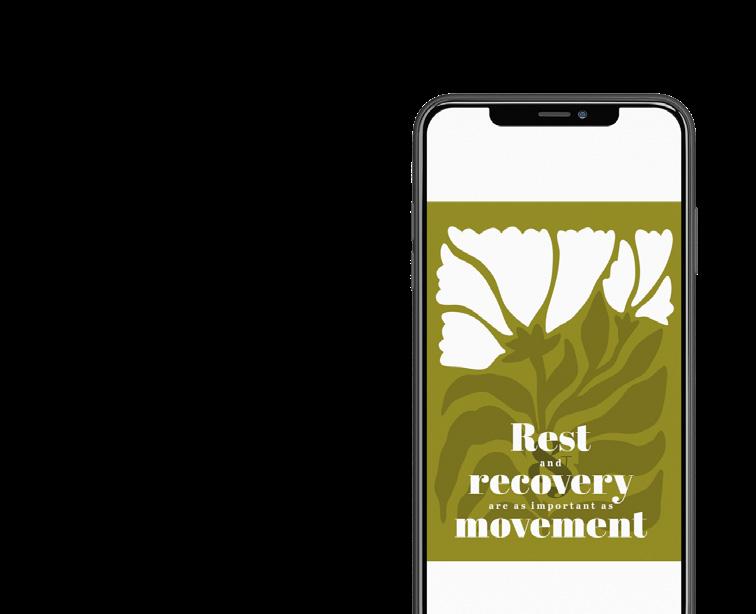


Beyond our award-winning monthly magazine, our shop hosts a range of creative items, designed to inspire, engage, entertain, and empower you, including:
Anti-anxiety guided journal
Self-reflection guide
Reflect & flourish: affirmation cards
Winds of change: 3-piece artwork collection
Question of thought: puzzle booklet
DIY self-care booklet
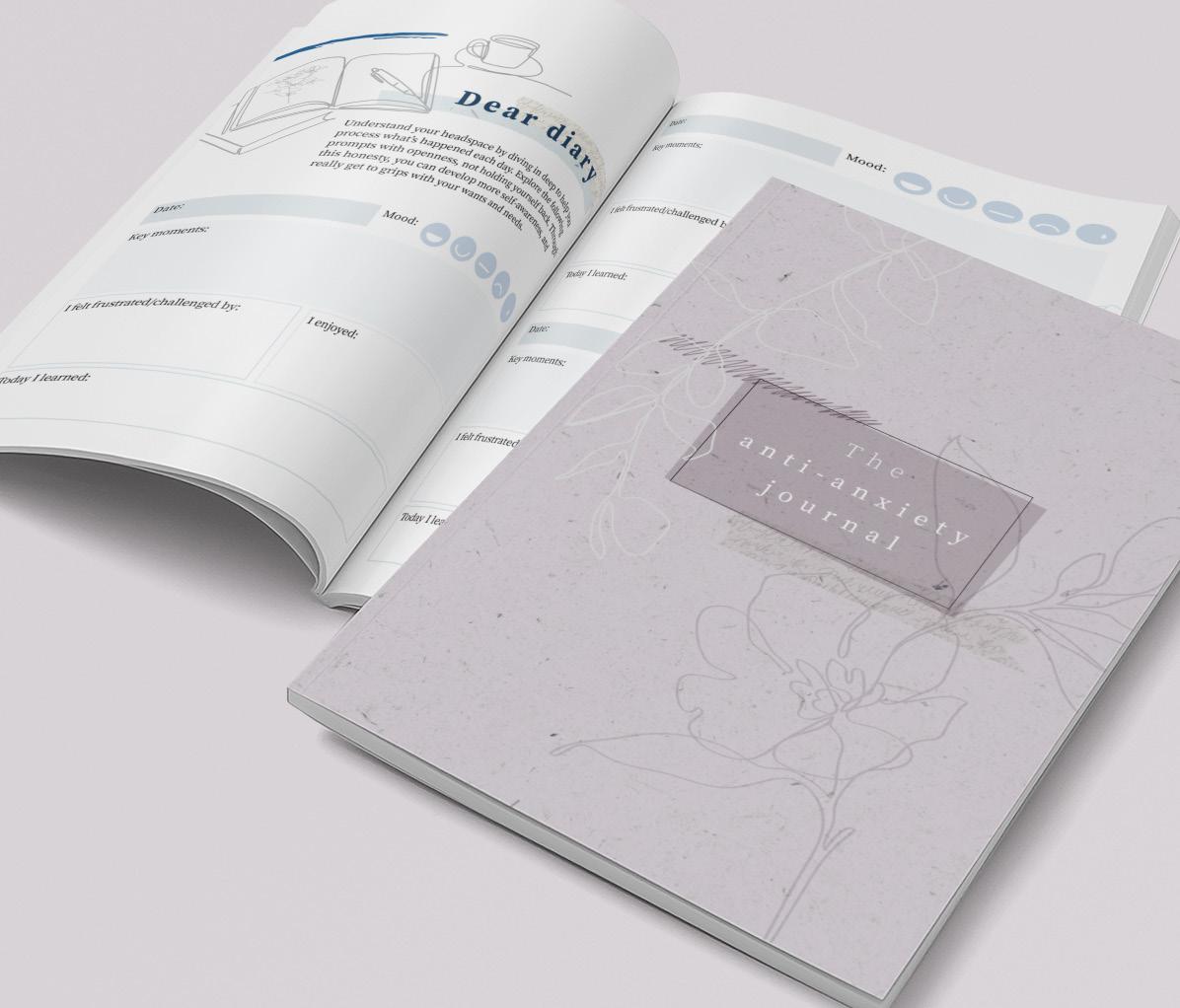
From our print journals helping you gain a deeper understanding of your true self, to our digital downloads featuring uplifting sentiments and actionable advice, continue your wellbeing journey with us.
From those snarky back-handed ‘compliments’ to criticism that doesn’t feel constructive, the offensive out-of-the-blue remark, or the subtle digs that wear down your self-confidence, it can be hard to know what to do when someone insults you. To help in those sticky situations, here are seven options for how to respond…
HOLD ON TO HUMOUR. This can be trickier, as, with all comedy, timing is everything. But if you feel confident that you can keep things light and jokey, you could dissipate any tension with a witty remark.
ASK ‘ARE YOU DONE?’ This is a more direct response, probably for those times when someone seems to be relentlessly picking on you in the name of a ‘joke’ or ‘banter’. Keeping calm and asking this question shows that you’re above the pettiness, and puts the spotlight back on them. If they ask what you mean, you could be clear by calling it out: “Are you done with putting me down?”
DON’T ENGAGE. That’s right, you don’t have to say a thing. Whether they’re trying to get a rise out of you, or attention for themselves by putting others down, if you don’t reply they don’t get what they want. It also means either the conversation can move on, or the silence puts the awkwardness on them.
‘COULD YOU REPEAT THAT?’ It’s a simple technique, but pretending that you didn’t catch what they said and asking them to repeat it may well make them think twice about their words. If they were trying to be ‘funny’, it’s certainly not going to be the same the second time around…
AGREE WITH THEM. This completely depends on what the person says, but if it’s a critique,
keeping things light-hearted and agreeing to an extent (whether you actually do or not) will make it seem like their words are bouncing off you – and not having their desired effect. For example, if you’ve made food for people, and ‘that friend’ makes remarks about what a terrible cook you are, you could laugh and say: “Yeah, I’m not the best cook, but I’m trying.”
CATCH THEM OFF-GUARD WITH A COMPLIMENT. An option, following on from the previous point, is if you agree with them, you could flip the script by redirecting things to them in a positive way, such as: ‘I know you’re a good cook though, do you have any tips for me?’ It’s pretty hard to keep being mean to someone, or put them down, when they respond with kindness.
‘ARE YOU OK?’ It might not be your first thought, but asking this is another way to put the spotlight back on to them. If this is out of character, it could be said with the intention of acknowledging that, and recognising they might be projecting or deflecting from other feelings. Or, if it’s a consistent pattern of behaviour, you could continue by directly addressing it: “Are you OK, because that was incredibly rude/ inappropriate?”
Remember, someone else’s opinions are just that – and just because they share them loudly doesn’t mean they’re fact, or true. However you decide to handle things in the moment, just know that you don’t need to take their words to heart.
An expert-look into how to open up your throat chakra to see your communication flourish
Igrew up as a shy child, with a fear of speaking up in case I was misunderstood or judged. A consequence of this was that I became timid and only replied, or rather mumbled back, when I was spoken to.
In my teenage years, I had my tonsils removed, followed by episodes of glandular fever, and I eventually developed an underactive thyroid in my early 20s. Although this cannot be proved in a medical sense, I personally believe that all of these were a result of the energy blockage, linked to my throat chakra.
Chakras are considered to be the main energy channels within the body, running from our heads down to the base of our spine, and resemble a spinning wheel or disc, which when imbalanced may lead to physical or emotional symptoms. It’s believed that there are seven chakras in the body, each with its own emotional and spiritual benefits.
According to ancient yoga, the throat chakra (which is the fifth, and known as Vishuddha),
represented by the colour light blue, can significantly impact your ability to communicate effectively, as the stagnant energy can hold you back from expressing your truth. However, when this fifth chakra is open and flowing with ease, you are able to express yourself with clarity, confidence, and honesty in any situation.
Two decades after I first discovered the chakra system and began applying it to myself, through yoga, meditation, reiki healing, and Neuro-linguistic programming (NLP), I am now a confident speaker and writer. I express myself through various mediums including poetry, podcasts, and blogs. I deliver workshops for large groups of people; something I could never have imagined doing when I used to stumble to get my words out!
Located in the centre of the throat, this chakra is associated with communication, self-expression, and speaking one’s truth.

Nikita is a multifaceted teacher, mentor, and coach, combining transformative modalities to support people to find their life purpose. Visit the Therapy Directory for more.
While no scientific proof supports chakras, in the spiritual sense, some scientists say it is linked to the thyroid and parathyroid glands, which regulate metabolism and calcium levels in the body.
Dr Joseph Loizzo, a Harvardtrained psychiatrist, clinical researcher and meditation scholar-teacher, suggests crossreferencing chakras with maps of the central nervous system. For instance, the throat chakra aligns with the limbic system, which is associated with communication and self-expression. While chakras remain as metaphysical concepts, their symbolism and impact on wellbeing continue to inspire exploration and discussion, particularly among energy healers.

The connection between physical ailments and psychological states is very much a topic of discussion and debate, and while the medical community may not fully endorse the concept of chakra energy blockages, many find value in the metaphor to understand their personal experiences. When the throat chakra is balanced, it is believed to facilitate clearer communication and truthful expression, allowing individuals to convey their thoughts and feelings with confidence, as in my experience.
The best thing is that you can do any of these by yourself or in a group! For example, consider attending a toastmaster’s group to develop your public speaking skills, joining a choir for singing, attending a kirtan for chanting, or even enrolling on to a creative writing course.
Opening the throat chakra allows us to align our head and heart so we speak the same way that we think
Here are a few ways you can start opening your throat chakra:
• Public speaking/debating
• Singing/chanting
• Creative writing, journaling, or poetry
• Humming
• Breathing techniques
• Yoga postures, such as shoulder stand, cat-cow, child’s pose, cobra, and fish posture.
• Connecting with the colour of the chakra (light blue) develops our relationship with that energy channel.
• Hands on energy healing
Opening the throat chakra allows us to ‘find our voice’ and align our head and heart so we speak the same way that we think. It also enables us to express our opinions, approach confrontations, and be brave enough to speak up with courage and confidence. Similarly, being able to ‘read the room’ and holding space for others to express themselves is a key characteristic of a balanced throat chakra. Overall, it is about being heard, understood, and making an impact on others by contributing to the collective conversation. Whether or not you believe in the concept of chakras, the underlying message is universal: growth and change are possible, and finding your voice can be a liberating and life-changing experience.
Three healthy and hydrating recipes to get you through the hot weather

Summertime is here and the heat is on! While it’s great to enjoy the sunshine, it’s equally important to stay hydrated to make up for the loss of fluids, and keep yourself feeling well. Water, or something from the bar, might be your obvious go-to, but if you’re looking for something healthy and a little more exciting to add to your alfresco lunches, garden parties, and BBQs, try these cool and refreshing alternatives that your body, and tastebuds, will love you for.
Serves 2
• Ice
• 500ml fresh tomato juice
• 2tbsp fresh lime juice or brine from a jar of green olives
• Pinch of flaked salt
• Pinch of freshly ground black pepper (optional)
• 2–3 drops of Tabasco (optional)
• 2 fresh celery sticks, to serve
• Start by adding ice to two tall glasses.
• Pour half the tomato juice into each glass.
• To each glass, add a tbsp each of the lime juice or olive brine, followed by a pinch of salt and pepper. Stir well to combine, and adjust to taste.
• Top with the Tabasco, stirring once more before serving with a stick of celery.

Ingredients
• 1 punnet of raspberries
• A large handful of blueberries
• Ice
• Fresh mint leaves
• 1 litre coconut water
• 2 tbsp elderflower syrup
Method
• Wash the fruit. Add 3/4 of the raspberries to a bowl and crush lightly with a fork.
• In a jug, add the ice and raspberries.
• Lightly crush the mint leaves to release their oils, and add to the ice and raspberries.
• Follow with the coconut water and elderflower cordial.
• Stir gently until combined.
• Finally, add the remaining fruit and give a final stir before serving.
Tip: Top with a little soda water or sparkling water if you prefer the fizz.
Ingredients
• 1–2 tsp of matcha powder*
• Ice
• 250ml of your milk of choice
• 1 tsp vanilla extract
• Date syrup or honey, to taste
*Ensure you use ceremony grade matcha as opposed to cooking matcha, which is a more refined version (lower quality). A good matcha should be a bright green colour, which is indicative of this.
Method
• Put the matcha into a bowl and add 3–5 tbsp of hot (not boiling) water, whisking to a smooth paste.
• Fill your glass of choice with ice.
• Top with the milk, vanilla and syrup or honey. Stir well to combine.
• Finally pour over the matcha, stirring into the milk, and serve.
Berries and citrus fruits, such as lemons and limes, are packed with antioxidants like vitamins C and A, and are a simple way to add instant flavour to summer drinks. The pigments in the fruit each offer a different set of phytochemicals, so using a variety not only makes your drinks look lovely, but is better for you, too! Vitamin C, in particular, helps
protect skin against UV damage, perfect to combat prolonged sun exposure.
Herbs, such as mint, and florals like elderflower, not only add character, but have a healing and anti-inflammatory effect on the body as well.
Coconut water can be referred to as ‘nature’s answer to an energy drink’. Rich in minerals including potassium and sodium, which are easily lost through sweating, coconut water is a great way to help rehydrate and make up for lost fluids.
This Virgin Bloody Mary takes all the flavour and fun of the original, without the dehydrating component of alcohol.
Tomatoes contain a range of phytochemicals, such as lycopene, potassium, and vitamins A and C, while celery aids with digestion, and helps to naturally lower blood sugar.
Finally, matcha is incredibly rich in antioxidants. Ten times more potent than green tea, matcha provides energy, clarity, immune protection, and aids healing. It’s also known to contribute to the body’s natural detoxification process, and is a great alternative to coffee without the jitters and diuretic effect.
Minal Sudra is a nutritional therapist and wellbeing coach who empowers clients to make informed choices and rediscover themselves. Find out more on the Nutritionist Resource.


“The monsters turned out to be just trees
TAYLOR SWIFT, ‘OUT OF THE WOODS’
we create an alliance?
We explore the concerns around chatbot counselling, the unique nature of human-to-human relationships, and where AI could fit in
Writing | Kat NichollsHow would you feel having a therapy session with artificial intelligence? This idea feels like science fiction, but it’s our current reality with apps and chatbots signalling a new era of mental health support. Some people see this as progress –increasing accessibility and even removing the element of human error, while others are more concerned.
“There are a few things to unpack here,” says Meg Moss, head of policy and public affairs at the National Counselling and Psychotherapy Society (NCPS).
The NCPS, a professional body for counsellors and psychotherapists in the UK, has recently launched a campaign called ‘Therapeutic Relationships: Honouring the Human Connection’, with the aim of educating members of the public, commissioners of mental health support services,
and the Government, about the therapeutic impact of human connection. By sharing the voices and experiences of experts in the profession, they hope to pose a counterpoint to the increasing use of digital mental health support in both the public and private sectors.
What is it they’re concerned about?
A reliance on chatbots is the first concern Meg shares.
“Reliance on chatbots may have negative, unintended consequences,” Meg explains. “For example, clients using chatbots as a crutch, without doing the difficult therapeutic work that clients of human therapists do outside of their sessions. By constantly having access to a ‘therapist’ in your pocket, a lot of that difficult and painful work that comes from striking out on your own, and learning to use the tools
you’ve picked up in therapy, is negated.”
There are also several questions about the construction and function of chatbots, including any unintended biases being programmed, and safeguarding protocols.
“Does the chatbot follow one specific therapeutic perspective? Can it adapt and learn in the way a human might? What is the bot’s cultural context, how can it understand the user’s own cultural context, and what incentive does it have to do that?
“The answers are none, it can’t, and it doesn’t,” Meg says.
The crux of the concern is the lack of human connection. The therapist and client relationship has proven to be important, with one study by Sharpley, Jeffrey, and McMah (2006) revealing that more than 80% of the positive outcomes of therapy may be due to the therapeutic relationship itself. >>>

Why is the human connection so powerful?
So, what is it that is so special about human connection in therapy? Perhaps counterintuitively, the answer is risk.
“When you enter into a relationship with your therapist, you have no idea whether they’re going to like and accept you after you share your deepest, darkest secrets with them. You walk into that room, or you look into their eyes through your monitor, and you become vulnerable to the
judgements of another human being.”
This risk happens because, as social animals, we’re hard-wired to seek acceptance. We can especially seek it from someone in an authoritative role and, often, therapists become an extension of those types of relationships.
“Acceptance is not guaranteed from human therapists though; unlike a chatbot, for example, that’s programmed to respond to your input in a positive and accepting manner,” Meg notes.
“Therapists go through years of training and self-development, so they can show up and accept you for who you are, no matter how terribly you feel you’ve acted, or how much shame you’re carrying around with you… and this is where the magic happens.
“You’ve emptied your soul on to the metaphorical table, rummaged around in its contents with your therapist by your side… and they still like you. They still care about you. They remain warm, open, affirming, validating.

We can be really creative about how we use technology to support therapeutic work, so long as it’s clear that there is no way of coding humanity into AI
“AI is an amazing, powerful tool that will undoubtedly change our lives,” Meg reminds us. “It’s free or very cheap to access, there when you need it, and offers a way of working through things that appeals to people.”
They see the good in you – the human in you – and they accept you for who you are.
“That is where therapy really happens. ‘No risk, no reward’ is a common idiom, and it applies here as much as anywhere else.”
While we may be able to get a sense of relationship from technology, without this risk it can ultimately ring hollow.
Another element of human-tohuman connection that’s difficult for AI to replicate is being aware of non-verbal cues, such as facial
expression, body language, tone of voice, and even silence. Meg highlights that this is something human therapists are trained in.
“A therapist uses their empathy and training to decode what all of these elements together are trying to say. Sometimes we say one thing, but our body language and expressions tell another story.”
Can AI be helpful in therapy?
We are still in the early days of AI, and while there are concerns and questions, it isn’t all doom and gloom. There is a good chance that technology will become more and more sophisticated, and potentially more and more helpful.
One way of utilising it could be to use a chatbot in a similar way you would a journal, Meg suggests. “When we write our feelings to a therapy chatbot, it can be a great release of built-up thoughts and emotions – much the same as journaling, which is a wellestablished complement to talking therapy. Doing that with a chatbot just takes a more active approach.
“It’s worth being mindful of data protection issues, however, and people have to decide for themselves what level of risk they’re comfortable with.”
With all of this in mind, is there a way for therapy and AI to form an alliance? For Meg, the key to this is boundaries, and not blurring the line between human and machine.
“We can be really creative about how we use technology to support therapeutic work, so long as it’s clear that there is no way of coding humanity into AI, and that those looking to AI tools as a therapeutic intervention understand it can only help so much.”
Supporting this, organisations providing AI need to be more transparent and ethical in how they use and store data, Meg says, “so that people can be more confident in using them”.
Technology and AI can no doubt help us progress. As long as we’re able to spot its limitations, and when a human needs to take the wheel, we can go far. Visit
Health anxiety can be paralysing for those who experience it. Here, we look into both big and small ways to address itWriting
|Rebekah Crilly
Ibanged my head on the cupboard. I was convinced I felt dizzy and nauseous, and my thoughts immediately went: “I’m going to die.”
While this event might be isolated, it forms part of the larger struggle for those who suffer from health anxiety. Our health is our greatest asset and when we perceive it is at risk, it is natural to experience symptoms of anxiety. But it is important to remember that there are tools that can prevent it from escalating and, in turn, minimise the overall hold health anxiety has over us.
As someone who has journeyed the tumultuous waves of health anxiety for the best part of 15 years, I can say, without doubt, that these techniques have come to loosen the grip it has on me.
In the immediate, we need to calm the body to affect any thought change, as our ability to rationalise is compromised when in this heightened state.
“This is all about developing coping strategies that work
for us when we are in the moment,” says counsellor Georgina Sturmer. She notes the effectiveness of breathing techniques, grounding, and affirmations – and recommends any activity that hones in on the connection between our sense of touch and breathing. By engaging our senses and bringing our attention to the present, we can shift our current thought patterns. “The challenge here is to find something that fits for you personally,” notes Georgina, which will come in time with practice.
For many people, it can feel like our anxiety came out of nowhere, but as Georgina explains it can be triggered by a whole range of factors. “It might originate from childhood fears, messages that we have internalised from our early caregivers,” she explains. “Or it can develop in response to medical treatment that we have received.”
In the long-term, it’s helpful to do some work around the root cause of our anxiety in order to prevent episodes of panic. “If we
can figure out where it originates from, and what it’s trying to tell us, then we can try to change our behaviours,” adds Georgina. With health anxiety, it’s helpful to acknowledge that these fears and worries are there for a reason. While it might seem counterintuitive – particularly when our thoughts are distressing – these thoughts have developed as “a mode of defence”, according to Georgina. If we explore the reasons behind them, then we can start to address the problem accordingly.
People who suffer from health anxiety tend to ‘catastrophise’ –a term coined by psychologist Albert Ellis to describe “the tendency to magnify a perceived threat, and overestimate the seriousness of its potential consequences”.
If we consider the cognitive triangle associated with cognitive behavioural therapy (CBT) – which demonstrates the relationship between what we think, what we feel and what we do – it is logical that this negative

thought pattern will impact our actions which, in a lot of cases, can lead to compulsive behaviours, according to Georgina.
In order to alter this type of thinking, we need to first acknowledge it. Georgina recommends keeping a thought diary as a helpful tool to track the thoughts and feelings that we experience around health anxiety, making it easier for us to notice patterns and triggers, and to look back to see if our catastrophic fears really did materialise.
“If we find ourselves stuck in a loop of negative thoughts or behaviours then we can, without thinking, keep ourselves stuck there,” Georgina warns.
If we become obsessed with Googling symptoms or seeking reassurance from others, we are only further fuelling our anxious thoughts.
Receiving medical attention will provide a brief sense of relief, but only serve as a temporary solution to the problem. By engaging in these practices, you are only reaffirming the existence of a threat, and relying on external validation that one doesn’t exist. Instead, according to Georgina: “We need to think about healthier coping strategies that might offer distraction, and a sense of perspective.”
It is said the Buddha once asked: “If a person is struck by an arrow, is it painful? If the person is struck by a second arrow, is it even more painful?”

Georgina Sturmer is a counsellor who specialises in supporting women. Check out her profile on the Counselling Directory.
In life, we can’t always control the first arrow. However, the second arrow is our reaction to the first. It is optional. Instead of arguing with our thoughts, we can forge a different relationship with them – one based on acceptance. If we can accept anxiety as something that we all experience, it can help us normalise it and its true purpose.
What can we all learn from the LGBTQIA+ community about the importance of chosen family, when it comes to our mental health?
Writing | Jamie WindustThe first time I came across the concept of a ‘chosen family’, it almost felt daunting. As if a parade of fellow queer people were going to be walked out on stage, X Factor-style, for me to choose from, granting them the prize of officially becoming a part of my ‘new family tree’, and rendering those left to go home and apply again next year.
In actuality, it was far from the fantastical experience I had manufactured in my head, and instead distilled with a sense of fluidity and depth that comes with the ability to choose one’s inner circle. A chance to choose what one needs when it comes to connections that may have been missing previously. It is the opportunity to fill one’s life with people who enrich it and make it better – which, although synonymous with queer community, is something we can all benefit from, especially when it comes to finding community in mental health circles. But how do we get there?
It was 2020 when I first went on antidepressants, and I distinctly
remember reading the booklet that was neatly folded inside my prescription in the park under a huge tree that showered me in shade. Through the tiny letters and reams of paper, I realised that I didn’t personally know anybody who was on this medication at the time – or anything similar – and, amid the global pandemic, felt like this new venture would be one I would have to take alone.
But, even in one of the world’s darkest of times, community was still available to me, albeit digitally. By being vulnerable online, and speaking to the internet in the haphazard way I often do, throwing out my current circumstance like a fishing line and waiting to hear if anyone bites, I was able to ask for help. Through sharing my inexperience with mental health medication with those whom I felt comfortable to do so, I was able to uniquely ask for help, and find a chosen unit of people who had similar experiences, much like I had done when I came out as queer. It was my positive experiences of finding
queer community that made me confident to know that there must be an equivalent out there for those of us who need a bit of help in between our ears. Despite the invaluable conversations and relationships that I formed during that time, it wasn’t all sunshine and rainbows – far from it. Even before the pandemic, the mental health landscape in the UK had been on its knees, with waiting lists for talking therapy growing exponentially. Young people are often hit hardest, with one in six six to 16-year-olds identified as having a mental health problem in 2021, according to a survey by NHS Digital. For LGBTQ+ people, the story felt bleak, too. According to LGBT+ Hero, a national health and wellbeing charity in the UK, between 2020 and 2021, 80% of LGBTQ+ people identified that the coronavirus Pandemic had impacted their mental health, with 50% saying they felt anxious ‘very often’ or ‘every day’.
I felt this too; a distinct lack of closeness with a queer community that are often so
IT IS THE OPPORTUNITY TO FILL ONE’S LIFE WITH PEOPLE WHO ENRICH IT AND MAKE IT BETTER

tactile and together, combined with financial and economic insecurities from not working, resulted in queer-specific challenges alongside the overall isolation lockdown created.
Before the lockdown, I had been exploring who I was as a queer person for the first time, and now this was cut off from me – making it harder to find my tribe. I struggled with the idea that part of my growth in this world was being stripped from me, resulting in a sense of desperation and loneliness that echoed the world over.
But one thing that queer people have within us, as if pre-programmed from birth, is resilience. From our queer siblings that went before us, passed down through the generations, is a determination to make things work, no matter how hard they may be. So, when push comes to shove, we can still help each other out, and support those who have it even harder, because that’s what it means to be a part of a community.
I learnt that I, too, had that resilience in me, even if I had to dig to find it. By speaking to fellow queer people day in and day out throughout 2020 and 2021, I was able to realise how strong I actually was. I’m thankful to my community for shining their light on me to allow me to find out what I am >>>
truly capable of in my darkest moments.
By asking for help, I was able to see those that would be there for me as much as I would be for them – allowing my inner circle to fluctuate with new faces, as well as witnessing departures from those who no longer were able to support me. By speaking up about my mental health diagnoses, and the newness that I was experiencing with my medication, I was able to create a chosen family that was uniquely mine.
Through speaking with likeminded queer folk, I was able to find an LGBTQ+ specific therapist in the coming weeks who perfectly matched my needs, and further evolved my relationship with myself – something that would’ve been impossible if I hadn’t taken a chance and asked for help.
Four years on, I have realised that we all should have the ability to find our own version of a chosen family. The root of our decision to find a group of people outside of our biological ties that we can connect with, is because at some point in our lives we wished more for ourselves. We dreamed of the possibility that there were people out there who could help us, as well as be helped by us. We wanted to be able to find people who could allow us to become better versions of ourselves, and vice-versa. So, although queer people often fall into this category more often, I would argue that we are all capable

WE DREAMED OF THE POSSIBILITY THAT THERE WERE PEOPLE OUT THERE WHO COULD HELP US, AS WELL AS BE HELPED BY US
of finding a chosen family, no matter how we identify.
Why? Because in a time when our mental health services continue to struggle as each day passes, the only way we’ll be able to collectively grow as a society is if we allow our walls to come down, and new branches to be formed on our ever growing family trees. May they blossom and reach out to those who sit under them one day, wondering what the future may hold.
Jamie Windust is an award-winning writer and author of ‘In Their Shoes: Navigating Non-Binary Life’. Follow more of Jamie’s work at @jamie_windust

What’s behind the ice bath trend, and could taking a freezing dip be the key to cooling a frazzled mind?
Writing | Kathryn Wheeler
Ihave always loved cold water immersion, often sea swimming and having cold showers throughout the year. During covid, I set up a cold water challenge, where we focused on the benefits of having cold showers, and increasing time under a cold shower to maximise health benefits and regulate emotional states. I wanted more, and began as an ice bath facilitator following my breathwork training in 2021. I attended a workshop and I was hooked.”
Claire Elmes is a breathwork and ice bath facilitator, as well as a therapist and coach. As she describes, ice baths very quickly became a staple in her wellbeing routine – and she’s not alone, as
in the past five years interest in cold water therapy in the UK has increased by 633%, according to data from digital marketing agency Antlerzz.
Considering the cause behind the boom, Claire first points to the popularity of Wim Hof (AKA The Iceman) who has 3.5 million followers, and whose BBC One series caused a noticeable increase in the requests she was receiving for classes. But she also points to the benefits that she and others enjoy.
“The benefits of ice baths are well documented, but for me the biggest is how it activates the autonomic nervous system, changing breathing patterns, and breath control altering heart rate variability and
triggering the body’s stress response (sympathetic nervous system). When you undertake a breathwork session and then do an ice bath, you take control of your breathing patterns, which, in turn, can help you to switch between the sympathetic nervous system and parasympathetic (rest and recovery).
“We need both systems to function, but many people – especially when stressed, overwhelmed, anxious, or getting regular panic attacks –don’t feel they can control the switch between the two. Along with all the physical perks, this benefit alone helps many clients I work with start to regulate their emotional states (you can even run hands under cold water).”

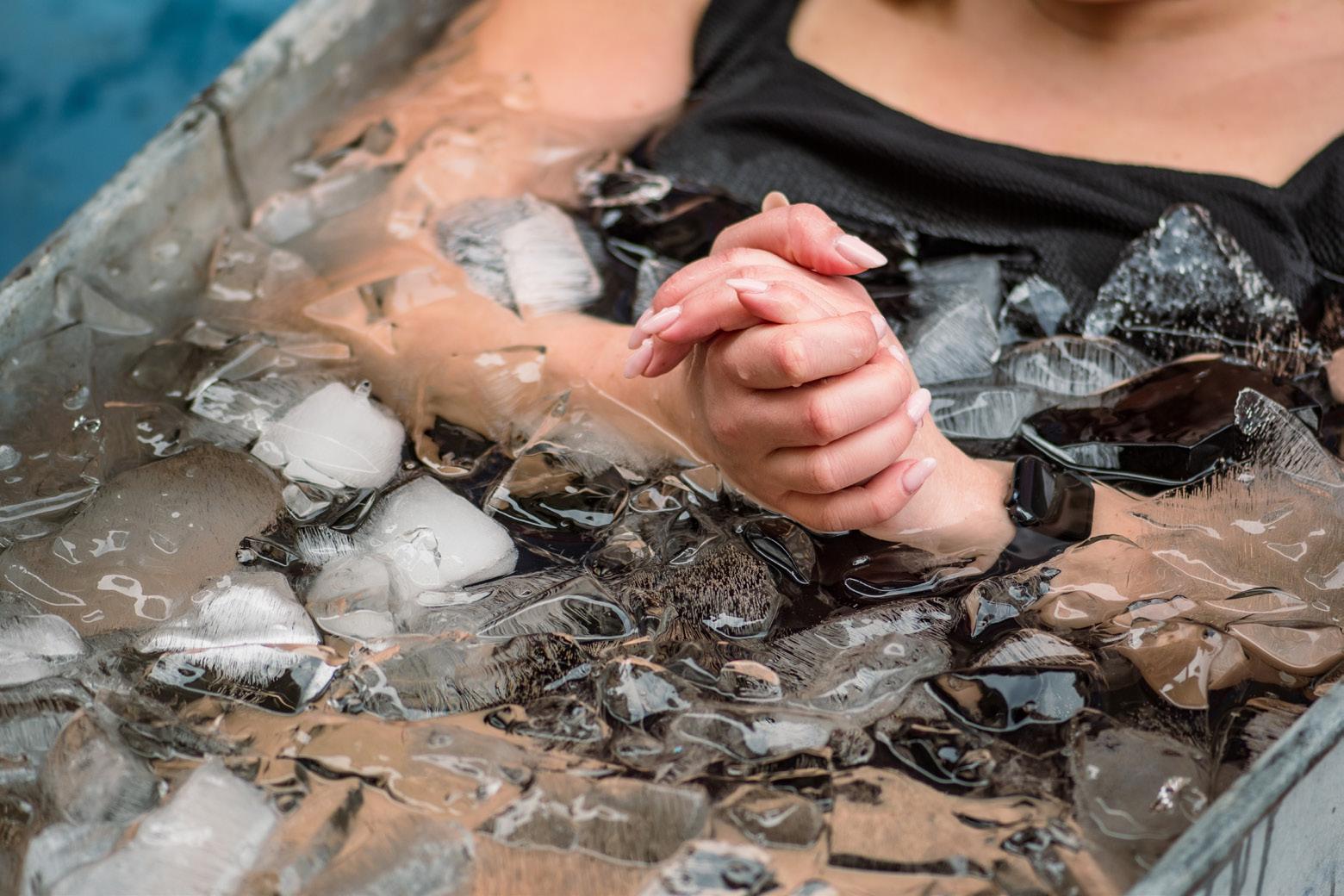
STARTING MY DAY OFF WITH AN ICE BATH IMPROVES MY MOTIVATION LEVELS FOR THE REST OF THE DAY, AS I HAVE OVERCOME A TASK WHICH I DON’T REALLY WANT TO DO. EVERYTHING THAT FOLLOWS FEELS LIKE A BREEZE!
Because the widespread use of ice baths for wellbeing is a fairly recent trend, most of the evidence is anecdotal, and studies tend to be fairly small in scale. But results so far do indicate a positive correlation. In 2008, a study published in the journal Medical Hypotheses examined how cold showers may be used to treat


depression. What the researchers saw was that cold hydrotherapy did relieve depressive symptoms effectively, and did not have any noticeable side-effects – though further research is needed to confirm these results.
More recently, in a Dutch study of 3,000 participants published in PLOS ONE, researchers found that people who took a daily cold shower were off work with selfreported illness 29% less than those who had warm showers. Other hypotheses into why people feel such a powerful effect include cold water potentially increasing
feel-good hormones such as endorphins, and decreasing the stress-inducing hormone cortisol. Some say ice baths produce a placebo effect – though that doesn’t mean the resulting good feelings aren’t real. So, with fairly limited research behind it, the best way to figure out whether or not it’s right for you is to simply give it a go.
At the start of January, ice bath brand The Ice Co invited followers to take part in a 30-day challenge. Shaun Grassham was one of the participants.
“I’d seen a lot of celebrities using ice baths, which led me to read about them. When I read the potential benefits, I couldn’t wait to give it a try,” he says. “I started

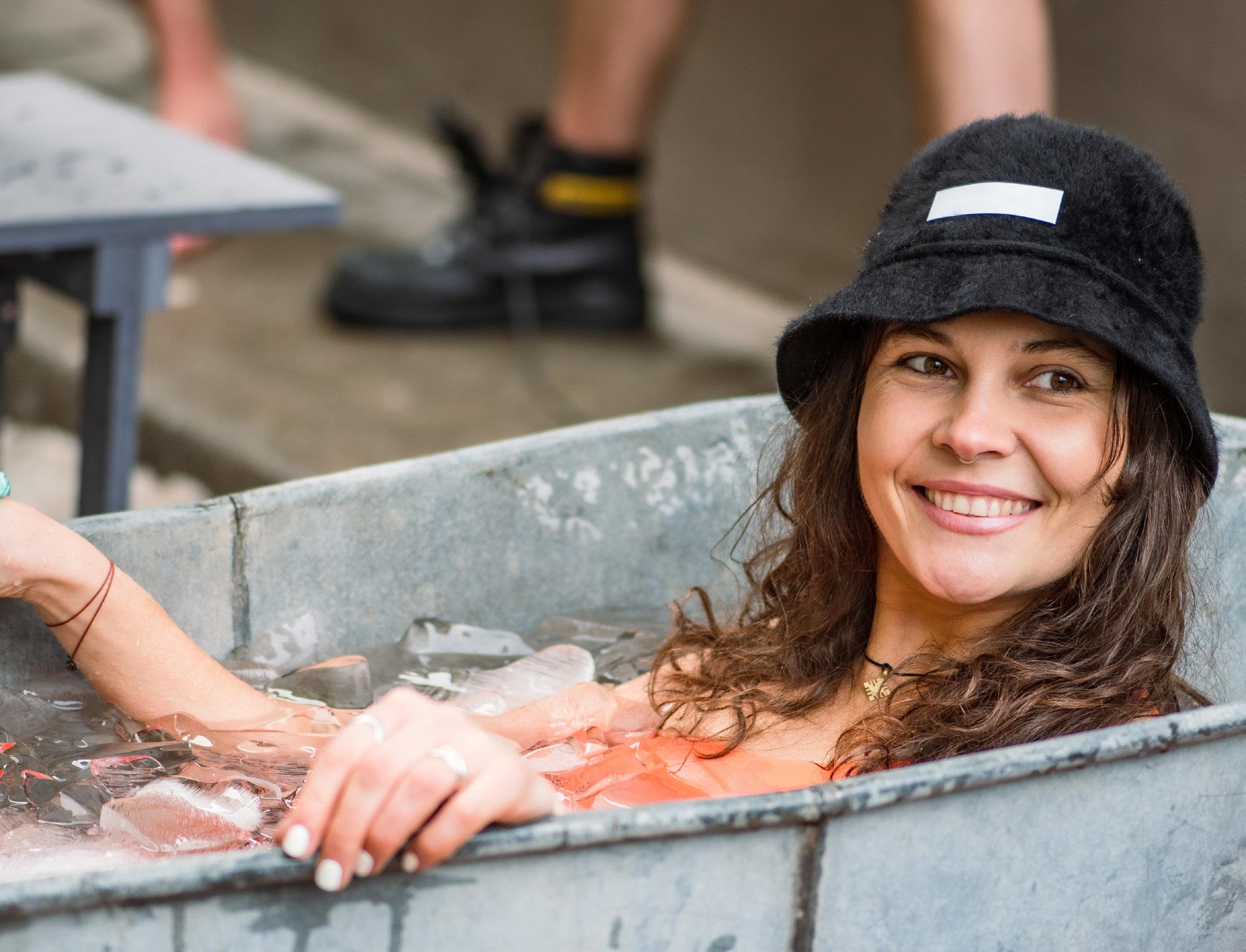

my ice bath journey in January and, trust me, the last thing you want to do before work at 6am, especially in the middle of winter, is jump into freezing cold water. But once you’ve prepared yourself and taken that plunge, each day it gets easier. I started with short stints, around 20 seconds to begin with, but I’m built up to the three minutesplus mark now.
“It has definitely supported my mental health. It strengthened my mindset for the day and helped me build a routine.
Starting my day off with an ice bath improves my motivation levels for the rest of the day, as first thing I have overcome a task
which I don’t really want to do. Everything that follows feels like a breeze!”
“I have seen the most lifechanging experiences for people who have participated in ice baths and cold showers regularly,” says Claire. “I personally enjoy ice baths because it gives me a buzz and energy that helps me focus and be more productive. It also allows me to release the stress and get my body back on track. Even my kids enjoy a cold water burst after a shower, and I notice the difference in their ability to emotionally regulate.”
Are you tempted to give it a go and take the plunge yourself?
You certainly don’t need to splash the cash to get all the gear right away. A simple way to begin is by turning down the temperature of your shower little by little until it runs cold. When you’re feeling confident, look into ice baths and cold swimming near you, and follow the guidance of professionals like Claire. You never know, taking a cool dip could be your next transformative wellbeing hack.
Put your feet up and enjoy a mindful pause with these puzzles
To solve this compact crossword, use the clues to uncover the missing words in the grid. To help you out, each letter that features is noted below, so this can be completed, even if you’ve only got a few minutes to spare.
DOWN
1. Sausage dog
3. Stolen goods
4. An exclamation!
ACROSS
2. Fortunate
5. Follow in someone’s
6. Not north
YOU’LL
Complete the pyramid by solving the clues, filling in each row with one letter per box. The trick is that each row uses all the same letters as the row before it, plus one new letter – but the order can change. Time to test your vocabulary!
CLUES
1. Me
2. Exists
3. Title 4. Ascend
5. Alarm

Could learning to play football as an adult be a game-changer when it comes to improving your mental health?
Writing | Ellen ManningWhen Joe Kibble moved to a different part of London, midway through his doctorate training as a clinical psychologist, it was tough. Recognising signs of stress, he was looking online for some kind of activity that would help him cope when he stumbled on adult football training sessions aimed at beginners, and decided to give them a go. Fast-forward nearly six years and the sessions, organised by Experience Footy, are not only a highlight of his week, but a nonnegotiable part of his self-care.
“I was training to be a clinical psychologist, which is notorious for being stressful and demanding,” the 34-year-old reflects. “I’d also split up with a partner a few months before and, having moved to north London, a lot of my friends were still in the south, so I felt a bit isolated. In the past, I had used running as a way of coping, but actually found it pretty boring. Football was something I enjoyed watching, talking about, and every now and again playing, but didn’t feel particularly confident with. When I was a kid I didn’t play, and only
got into it when I was a teenager. By that point, all my friends were better than me and I felt a bit intimidated.”
Unlike other groups he’d seen, Experience Footy seemed to be more structured, teaching the basics to help gain confidence, and offering the chance to join in one-day tournaments where people wouldn’t feel intimidated by better players – which was exactly the aim founder Raphael Kopel had when he set it up in 2018 as the first-ever social enterprise providing football coaching sessions for beginner >>>

adults. Like Joe, he decided to start playing football as an adult, but realised it was virtually impossible – with most leagues set up for people with experience. So, he persisted until he learned, then took his own coach’s qualifications so he could help other adults start, and, in 2020, created a league of his own aimed at beginners. His initiative, which organises weekly five-a-side football leagues, as well as tournaments and dedicated events for business people and children’s charities, hasn’t just provided adults across London with a place they can learn and practise a new hobby, but also provides much-needed support for many.
“I had my own mental health struggles during the pandemic, which may explain why I am so aware of the mental health of my members,” explains 45-yearold Raphael. “I got Covid in the summer of 2021, which resulted in a bout of insomnia and very low mood for a few weeks. It could have been a lot worse, but going to football every Sunday really helped me get through it.”
Since he set it up, Raphael’s group has flourished, and is full virtually every Sunday. It’s become a community where people meet outside football, doing everything from grabbing a drink to going backpacking together. All of this, plus the initiative’s WhatsApp group, has proved invaluable for many, says Raphael, with some members telling him it’s been vital to their mental health.
It’s certainly something Joe experienced. “My football ability gradually got better, but it also had
a big impact on my wellbeing and mental health – it quickly became an important part of my week.”
The sense of community, of familiar faces to ‘check in’ with, was something that provided comfort, he says. Now a qualified clinical psychologist, he’s also confident of the well-documented positive effects exercise can have on mental health, citing 2024 research published in The BMJ supporting the idea that exercise can be as, if not more, effective as antidepressants for depression.
“The exercise they looked at in that study was more solitary, but I think there are added benefits to playing team sports. We know that for a lot of people struggling with depression, or general stress and anxiety, loneliness and isolation can be a part of that. Having that added layer of being around people, feeling even just a small sense of connection with another person, can have a big effect.”
The fact that football involves strategy and teamwork is also helpful, in Joe’s view. “You’re very mindful when you’re playing football. You’re in a bit of a flow state, because you’re having to think about so many other things – where your teammates are, what you’re going to do with the ball, where you need to be, who you need to mark. You’re in the moment, and less focused on other worries or stresses.”
Additionally, the communication involved can help people struggling with confidence or socialising, whether due to their mental state at the time, general awkwardness in social settings, or a hangover from the isolation of the pandemic.
“Playing football in a group can be a good way of allowing people who are not feeling confident socially to just be around people. You don’t have to engage in small talk, but maybe talk about the exercise you’re doing or the football at the weekend,” says Joe. “Then there’s another layer of communication when you’re playing – you’re having to communicate verbally and nonverbally and, as humans, we get something from that. Even if we’re not talking about ourselves or our lives, or having that ‘normal’ conversation, there’s a positive feeling that can come from cooperating with another person or team. And that might feel a lot more manageable for people who feel social conversation or interaction is difficult.”
The positive impact on mental health is something Raphael sees as hugely valuable. His group of aspiring footballers may change, due to being at different stages of their lives, or moving geographically, but its popularity remains proof of its importance.
“One of the things that is special is it’s for people of any age, colour, gender, any background,” Raphael says. “It’s such a mix – we’ve had people who are depressed, or people who are fine and just want to learn. It’s very eclectic.”
With several years’ experience as to how this kind of activity can help people, Raphael has some words of wisdom to those setting out on their journey. The first is to take things easy – and resist the urge to want to be as skilled as top-flight footballers. “People often compare themselves to the
professional players they watch, then get disheartened.”
On top of that, the benefits of committing to something regularly are clear – and that means showing up even when you don’t want to, whether that’s because you’re tired, it’s raining, or any other number of reasons.
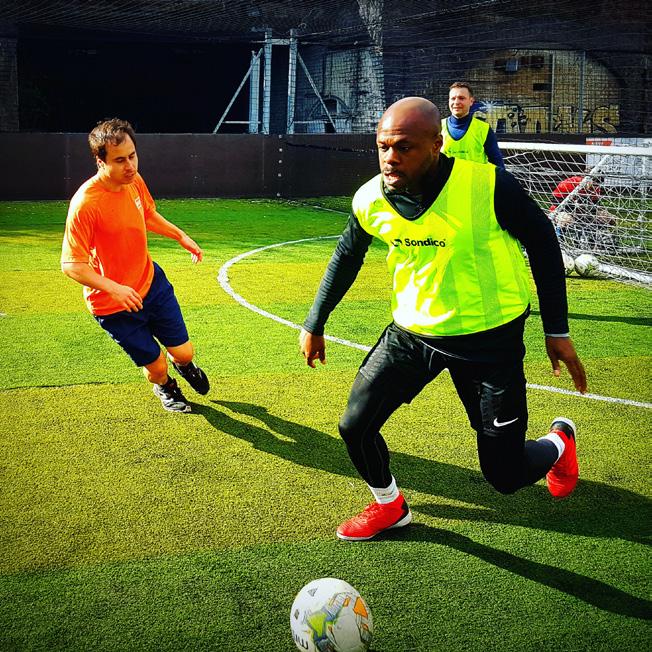

“When you’re in the same place at the same time, on a regular basis, this is when you notice certain things, and is the good thing about committing yourself,” he says. “It doesn’t have to be football – it could be yoga, it could be anything. But if you commit yourself then it becomes part of your routine and you feel the benefits, you build up a bit of resilience, and that can help.”
From an act of kindness continuing the cycle of imaginative play to a creative lesson in knitting, add these 10 wellness-inspired suggestions to your list
Writing | Lauren Bromley-Bird1

The Magic Words by Joseph Fasano
If you’ve ever wanted to explore poetry, but felt overwhelmed by the thought of where to begin, The Magic Words is a fantastic guide that can help you put your story into words. With 50 fill-in-the-blank poems, you can start your poetic journey with confidence. (Out now, £14.99)
2
Go to an open-air theatre
3
Give your Lego bricks a new lease of life Lego Replay is a programme that helps you make your play more sustainable, by encouraging you to declutter your bricks by donating them back to Lego. Once collected, they are passed on to charity In Kind Direct, which delivers them to local schools and charities to help continue the cycle of imaginative play. (Head to lego.com/replay-uk)
4

‘Conversations in Company’ Suicide is not an easy topic to talk about, but it’s important that we have these conversations. For those who are bereaved by suicide, ‘Conversations in Company’ is a compassionate podcast that will help you feel a little less alone in your time of grief, and delivers advice and strategies for coping with it. (Available on all podcast platforms)
5
Amelia Hutchison | Art Therapist
Whether it’s a classic play or a toe-tapping musical, now’s the time to step into the enchanting world of openair theatre. A chance for live performance to merge with the beauty of the natural world, you’ll be centre stage to a sensory adventure that you wouldn’t otherwise experience when indoors. (Search online for events near you)
Amelia is an art therapist and psychotherapist who has her own practice, but she uses her social platforms to show how art can be a wonderful tool for wellness. She opens up a creative space for her audience by sharing tutorials to inspire self-exploration. (Follow @art_therapy_irl on Instagram)

7
Locket widget
If you have long-distance besties, the locket widget allows you to communicate through live photos that appear on their home screen. The wholesome feature gives you insight into the small moments of your friend’s everyday life, so that you can feel closer and more connected to them.
(Available on app store and Google Play)
Arm knitting
You mean to say you can use your arms to knit, instead of knitting needles? That’s right! Say farewell to traditional knitting and throw yourself into this unique trend that sees craft enthusiasts using their arms to weave giant blankets, and other large-scale projects. (Head to youtube.com to watch tutorials)
9
8
It’s all in the small things… Don’t let a busy life put you off from taking care of your physical health; there are many micro ways to insert physical activity into your routine. When you pop the kettle on, do some squats while you’re waiting for it to boil. Brush your teeth while standing on one leg, or consider parking your car further away from your office to walk the extra mile.
In the search for the UK’s best amateur pianist, we see a number of talented musicians take to public railway station pianos for their chance to win over the hearts of two of the most highly esteemed performers, singer-songwriter Mika and Pianist Lang Lang. Who will leave a long-lasting impression? (Watch on Channel 4 catch up)
6 10
Take a mental vacation to the coast this summer with this beautiful gift set, packed with goodies to bring a bit of peace and tranquillity into your life. The gift set includes a candle infused with a coastalinspired fragrance, a soap bar smelling of cedar and pine to mimic the outdoors, a dark chocolate bar featuring coastal artwork, and a bamboo teaspoon along with a stoneware mug. (£32, greentulip.co.uk)

For your chance to win, simply email your answer to the following question to competitions@happiful.com
Which is not a seabird?
a) Seagull
b) Puffin
c) Wood pigeon
*Competition closes 31 July 2024. UK and Northern Ireland only. T&Cs apply. Good luck!
Solitude is good for you, says science, so can we learn to be better at spending time by ourselves?
Writing | Kerry LawWhether you’re a social butterfly or a natural loner, science has discovered we can all benefit from voluntary solitude now and then. A study by the University of Reading, published in the journal Scientific Reports, found that chosen periods of solitude can boost our happiness and wellbeing by reducing stress and increasing feelings of personal freedom. Being alone – importantly, by choice – is good for you. So, can we learn to be good at spending time alone to reap the benefits for our wellbeing?
This is where ‘solitude skills’ come in. In her book, Alonement: How to be alone and absolutely own it, Francesca Specter argues the case for valuing solitude skills as much as we do social skills –cultivating them can help us feel comfortable in our own company, and spend our time alone wisely. With that in mind, here are five solitude skills to master to enable you to be brilliant at being alone…
Saying you want to be alone can come with the risk of making loved ones feel rejected. “It’s common to experience feelings of guilt when prioritising ‘me time’ over time with family or friends,” explains Claire Elmes, therapeutic life coach at Inspire You. “But, without alone time, our social batteries can deplete because we aren’t giving ourselves the chance to properly regulate our thoughts and feelings. This can lead to irritability and tension in our interactions with others.
“Communicate openly about the importance of self-care and alone time. Encouraging others to also take moments for themselves can help normalise the practice and reduce feelings of rejection,” she says.
Dana Moinian, a psychotherapist at mental health clinic The Soke, adds: “Seclusion can give us the opportunity to reflect, imagine, recharge, and create, becoming
the best version of who we can be, both for ourselves and for those around us.” She agrees that communicating these benefits can help remove any sense of insecurity in others.
Once loved ones understand the benefits of alone time, you’re ready to embrace a positive kind of ‘selfishness’. In Alonement, Francesca describes this as unashamedly doing whatever you want in a way that doesn’t hurt anyone else. She believes that once your own desires have been met you’re more likely to be amenable to compromise when with others.

‘Positive selfishness’ could involve lunch at your favourite café without inviting a friend; watching an eagerly anticipated film at the cinema without taking your partner; enjoying an afternoon off for a spa treatment alone. Whatever it may be, if it’s not hurting anyone, give yourself permission to please yourself.

‘Me time’ doesn’t just appear, you need to create it. In her book, Francesca recommends forward-planning ‘solo dates’, for both practicality and joyful anticipation. Adding solo activities to your diary gives solitude equal importance to social occasions, and ensures you commit to and prioritise alone time regularly.
Why not make a list of things you want to see and do over the next few months? The exhibitions, shows, gigs, films, and places you’ve always intended to visit. Some activities are more enjoyable with others, but if there is anything on the list that you’re happy to do solo, make it a date for your diary.
It can be easy to worry about squandering our precious alone time. However, Claire suggests solitude is also a great opportunity to ‘switch off’ by “using techniques such as mindfulness and journaling to disconnect from the outside world, and tune-in to our own thoughts and feelings. Selfreflection is crucial for maintaining emotional wellbeing.”
If scrolling on your phone or watching TV is too tempting when you’re alone, you shouldn’t feel guilty, according to Dana. “Time alone is meaningful if it fulfils its purpose, whether that purpose is rest or stimulation. [TV and phones] are, for many, a great way to take a rest from the pressures that may be weighing on their minds. That said, if we don’t occasionally allow our minds to wander, then we can’t maximise our capacity to think.”
Solitude can be joyful, but stay alert to the potential downsides. Claire warns: “Learning to overcome FOMO [fear of missing out] is essential. Often, when we choose to spend time alone, we may experience feelings of anxiety about missing out.”
“When aloneness gives way to loneliness, that becomes a strong sign that the individual has allowed isolation to leave them untethered from their community,” Dana adds. When these negative emotions creep in, nudging yourself into social situations, even if you don’t immediately feel like it, can help you maintain balance and a healthy connection with others.
Discover the empowering training enabling you to unlearn unhelpful habits and unwanted behaviours
Writing | Bonnie Evie ReadWe all have habits – big or small – that we would rather change, from not drinking enough water to engaging in revenge bedtime procrastination. But for those with diagnosable conditions, certain habits may actually be upsetting or distressing, and so breaking these might feel like something that they need to do. And while some of these behaviours may fluctuate depending on events in our lives, or change over time on their own, others can require help for us to replace them with newer, healthier alternatives.
Also known as habit reversal training (HRT), habit reversal therapy is an evidence-based treatment most commonly used to bring attention to tics and other unwanted behaviours, thereby helping the person affected gain better control. While it was first developed in the 1970s by psychologists Nathan Azrin and Richard Nunn as a treatment for nervous tics and habits associated with Tourette’s syndrome, in more recent years it has also been used to help treat obsessive-compulsive
related disorders, as well as to help with unwanted behaviours outside of specific formal diagnoses. This process is usually done by following a number of steps including:
Awareness training. Together, the therapist and individual work to find the warning signs that occur before an unwanted habit (e.g. a specific thought, behaviour, or emotion), and to recognise situations where these typically happen. This helps the person to identify triggers and develop internal and external awareness of their behaviours.
A therapist may introduce relaxation training and self-care strategies, such as meditation, mindfulness, breathing exercises, progressive muscle relaxation, or visualisation, to help minimise stress levels.
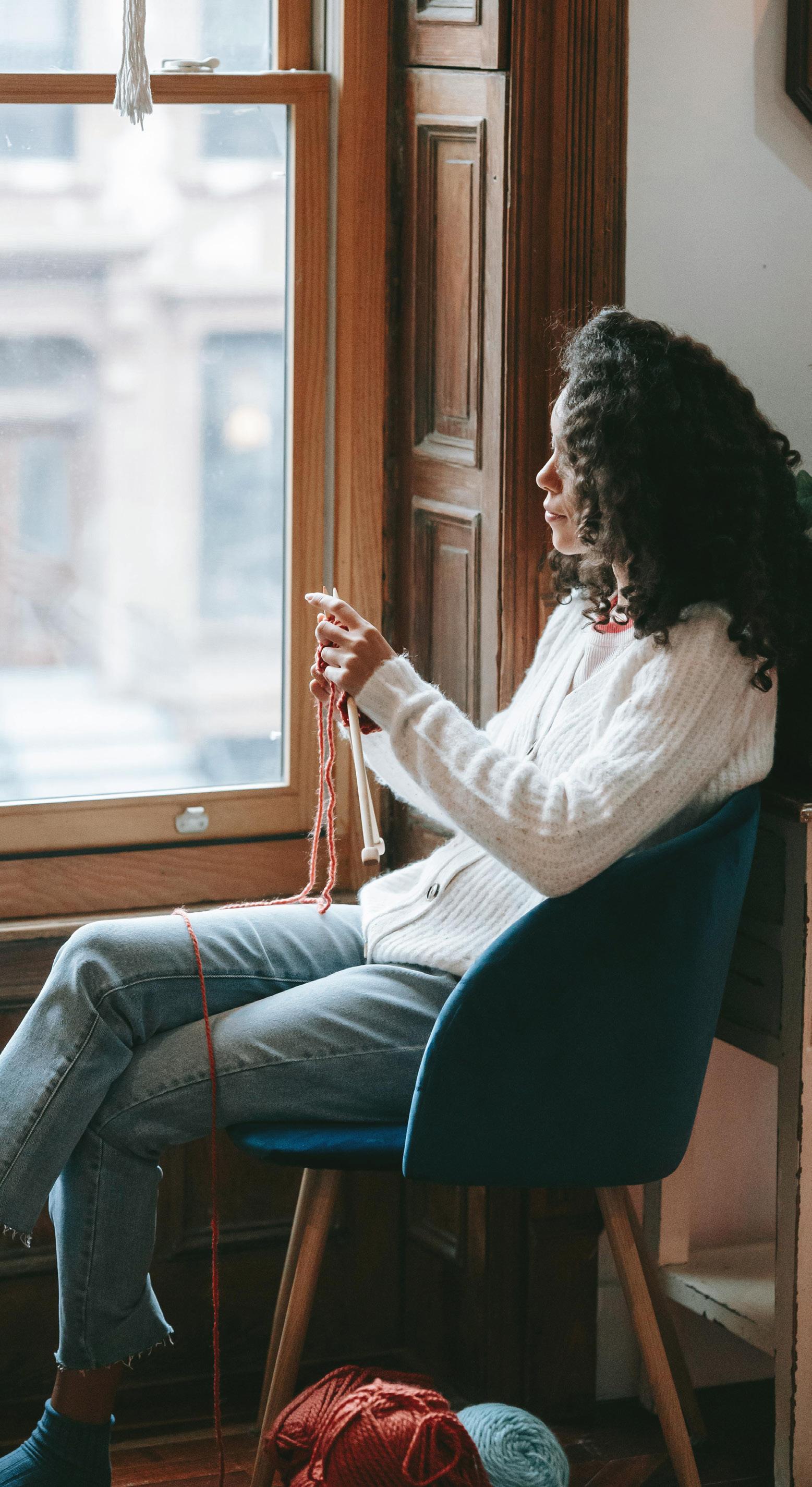
Competing response training. This involves collaborating with the therapist to implement more desirable behaviours to replace old, unwanted ones. For example, someone who bites their nails may instead be encouraged to chew gum – allowing them to engage in a similar behaviour that doesn’t have the same unwanted consequences.
Relaxation. Stress can often cause unwanted habits to occur more frequently. A therapist may introduce relaxation training and self-care strategies, such as meditation, mindfulness, breathing exercises, progressive muscle relaxation, or visualisation, to help minimise stress levels.
Generalisation training. Helping to reinforce new, positive behaviours over time, generalisation training gets individuals to practise tactics learned to help them in different situations until these new behaviours become the automatic response when stressful situations occur.
The benefit of this treatment is that it can be applied to help reduce physical and verbal tics, change unwanted behaviours, and build new, healthier habits. There is a wide range of conditions and habits it can help with, from Tourette’s syndrome to tic disorders, and obsessive compulsive disorders, alongside impulse control disorders such

as trichotillomania (hair-pulling), nail-biting, or dermatillomania (skin-picking), and can benefit those struggling with both automatic and focused (deliberate) habits. It can also be helpful for those who stutter and fidget, along with people experiencing anxiety or depression, addiction, gambling problems, or who are trying to stop smoking.
Essentially, many people can benefit from habit reversal therapy, but it’s worth knowing that it’s particularly recommended for children with disorders such as OCD and Tourette’s syndrome, although it can help people at any age to break unwanted repetitive behaviours and habits.
Research has shown that HRT can be an effective form of treatment, with one study published in Functional Neurology in 2013 focused on evaluating the effectiveness of HRT to treat Tourette’s and other chronic tic disorders in particular. Reviewing the results of five relevant studies, it concluded that HRT can
significantly reduce tic severity in both children and adults. When it comes to treatment options, you also don’t have to go down one route alone. Therapists may recommend trying other forms of therapy alongside HRT, which commonly include cognitive behavioural therapy (CBT) or dialectical behaviour therapy (DBT).
As with any illness or condition, our experience and the impact of it on our day-to-day life can be unique. And so, our response to treatment types and what is most effective for us, will be just as individual, therefore it’s really important to explore different methods to find what is best suited to you.
While habit reversal therapy can improve unwanted habits or behaviours, the main thing to be aware of is that it is recommended that you work with an experienced, qualified therapist to do so. While the concept may resonate and appeal to you, without assistance from
an experienced professional, it can be possible to inadvertently replace one unhealthy behaviour or habit with another, such as replacing nail biting with smoking. This is why working with a qualified, experienced, trained, habit reversal therapist can help you to get the most out of this type of therapy.
Before starting sessions, you may be asked to provide information about what behaviours you are looking to change, or what condition you may be looking for support with. Some therapists may offer an initial introductory session to better understand your needs and what you hope to achieve, before beginning the official HRT sessions. Your therapist may explain more about what to expect, and if they incorporate any other kinds of therapy alongside HRT.
While there is no set time frame for habit reversal training to work, it is often delivered over a number of sessions over the course of eight to 16 weeks, though your therapist may recommend fewer or more sessions depending on your individual needs. It really is about working together to establish a treatment process that best suits you.
If this sounds like it could be an effective route for you, talking to a therapist can be a helpful first step. With time, commitment, and support, it’s possible to change unhelpful habits and behaviours for good.
Looking for support with your mental health?
Here are some places that can help:
If you are in crisis and are concerned for your own safety, call 999 or go to A&E
Call Samaritans on 116 123 or email them at jo@samaritans.org
SANEline
SANEline offers support and information from 4pm–10pm: 0300 304 7000
Mind
Mind offers advice Mon–Fri 9am–6pm, except bank holidays: 0300 123 3393. Or email: info@mind.org.uk
Switchboard
Switchboard is a line for LGBT+ support. Open from 10am–10pm: 0300 330 0630. You can email: chris@switchboard.lgbt

• Pass me on to a friend who might appreciate some articles.
• Get crafty and use me for a vision board or collage.
• Keep me on a coffee table to pick up when you need a boost
• Remember I’m 100% recyclable, so pop me in your recycling bin.

SUPPORT FOR DEPRESSION
To learn more about depression, find guidance, and access a community forum, visit depressionuk.org
For information about LGBTQ+ life, to connect with a community, and find support, visit stonewall.org.uk p15
INFORMATION ON ANXIETY
Discover more about what it means to live with anxiety, common causes, and guidance at anxietyuk.org.uk

LGBTQ+ COMMUNITY AND SUPPORT
Our two-for-one tree commitment is made of two parts. Firstly, we source all our paper from FSC® certified sources. The FSC® label guarantees that the trees harvested are replaced, or allowed to regenerate naturally. Secondly, we will ensure an additional tree is planted for each one used, by making a suitable donation to a forestry charity. Happiful is a brand of Memiah Limited. The opinions, views and values expressed in Happiful are those of the authors of that content and do not necessarily represent our opinions, views or values. Nothing in the magazine constitutes advice on which you should rely. It is provided for general information purposes only. We work hard to achieve the highest possible editorial standards, however if you would like to pass on your feedback or have a complaint about Happiful, please email us at feedback@happiful.com. We do not accept liability for products and/or services offered by third parties. Memiah Limited is a private company limited by shares and registered in England and Wales with company number 05489185 and VAT number GB 920805837. Our registered office address is Building B, Riverside Way, Camberley, Surrey, GU15 3YL.
